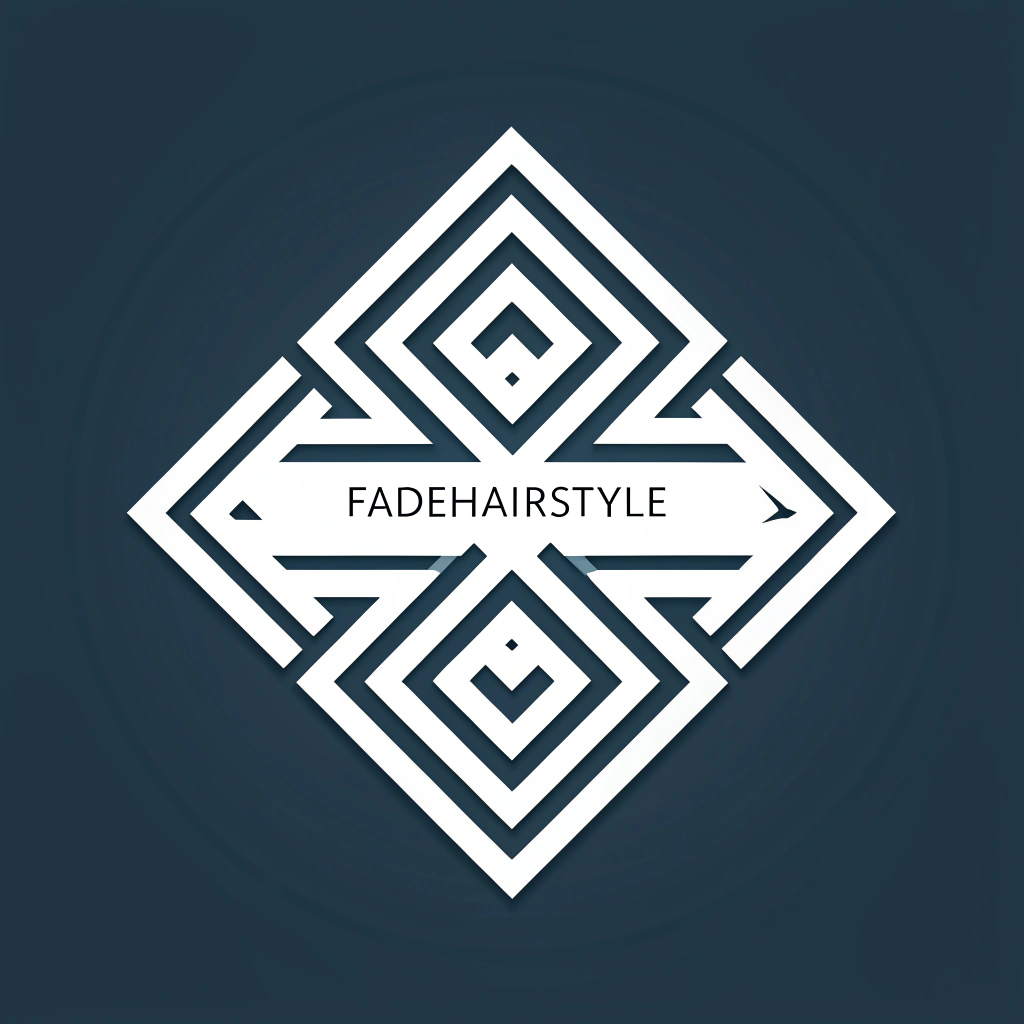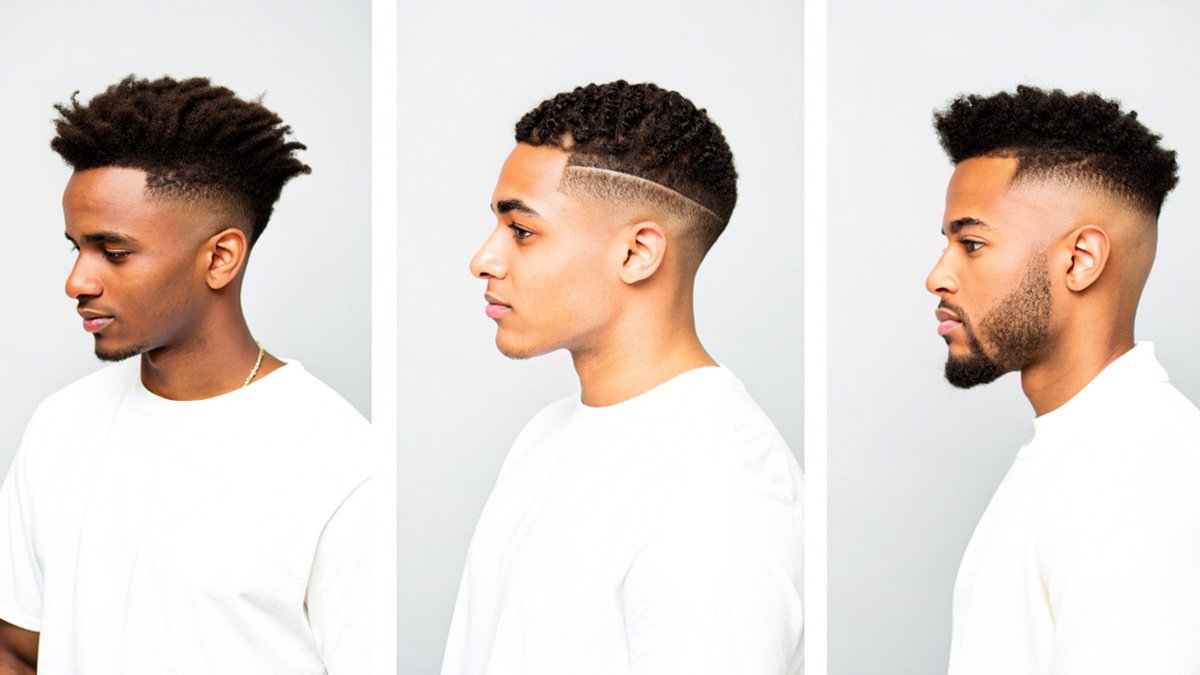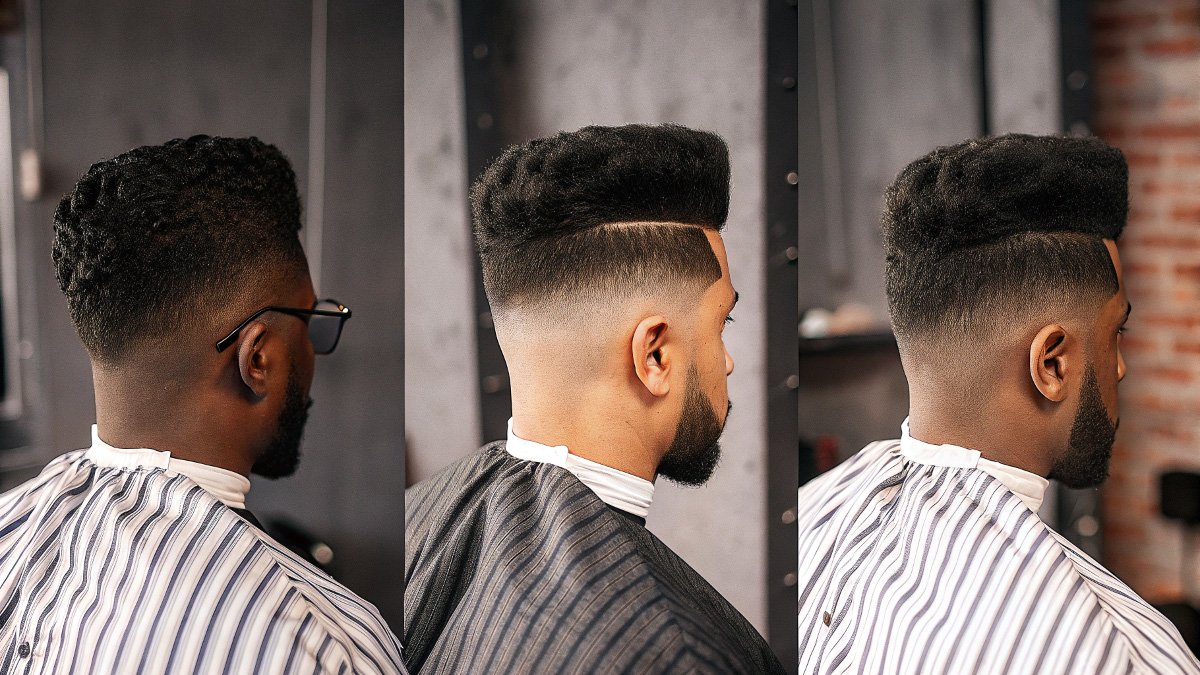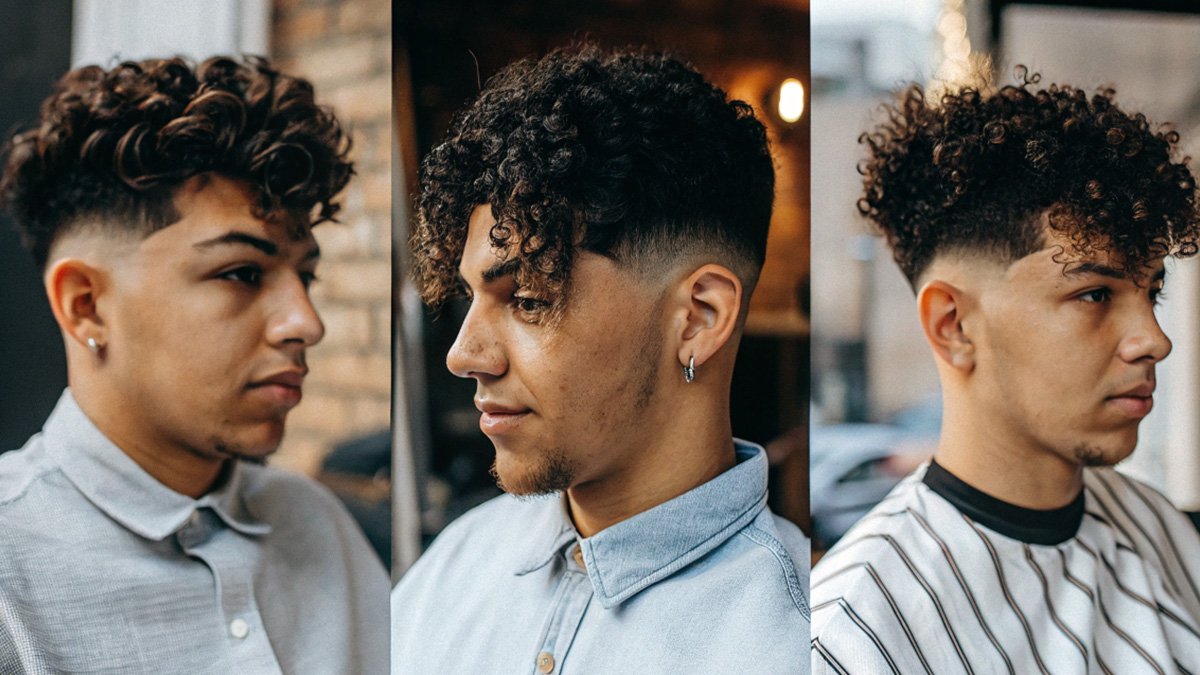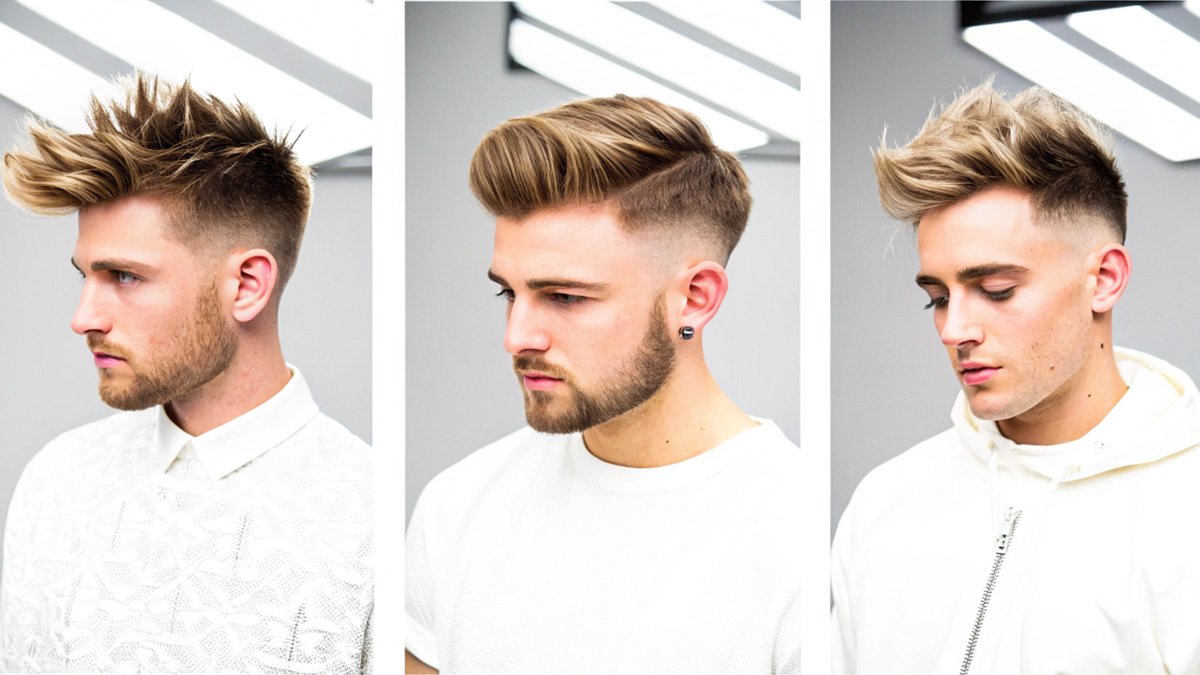Men choose fade haircuts for their clean appearance and style flexibility. Professional barbers create these cuts using precise clipper techniques. The fade technique blends hair lengths seamlessly from short to long sections.
Your barber customizes each fade to match your personal preferences. Different fade types complement various face shapes and hair textures. The right fade enhances your features while creating a sharp, modern appearance.
This comprehensive manual covers 60 distinct fade variations currently popular in 2025. Each style includes specific characteristics, styling methods, and maintenance requirements. Professional barbers recommend these cuts for clients seeking contemporary hairstyles.
Understanding Fade Haircuts
Fade haircuts feature gradual transitions between different hair lengths. Barbers achieve this effect using multiple clipper guard sizes. The term “fade” describes how hair appears to gradually disappear from one length to another.
Professional stylists begin with the shortest length at the bottom section. They progressively use longer guards while moving upward. This technique creates smooth blending between different hair lengths.
The fade haircut originated in military settings during the 1970s. Service members required neat, regulation-compliant hairstyles for uniform standards. Military barbers developed precise techniques to create clean lines and sharp transitions.
How Professional Barbers Create Fades
Experienced barbers use systematic approaches to achieve perfect fades. They select appropriate clipper guards based on desired contrast levels. The process requires skill to create seamless transitions between lengths.
Your hair texture influences the final appearance of fade cuts. Straight hair displays crisp, defined fade lines clearly. Curly hair produces softer transitions between different sections. Professional barbers adjust their methods according to individual hair characteristics.
Differences Between Fades and Standard Cuts
Standard haircuts maintain consistent lengths across different areas. Fade cuts feature deliberate length variations for visual interest. Regular cuts focus on overall shape and uniform length distribution.
Fade haircuts emphasize gradual blending between contrasting lengths. Standard cuts typically use one or two clipper settings. Professional fade cuts require three or more guard sizes for proper graduation.
Regular haircuts need basic trimming for maintenance. Fade cuts demand precise touch-ups to preserve clean transitions. This detailed approach creates the signature appearance that makes fades distinctive.
Popular Fade Haircut Categories
Modern fade haircuts fall into several distinct categories. Each category offers unique characteristics and styling possibilities. Professional barbers classify fades based on placement, style, and hair type compatibility.
Fade Position Classifications
Low Fade
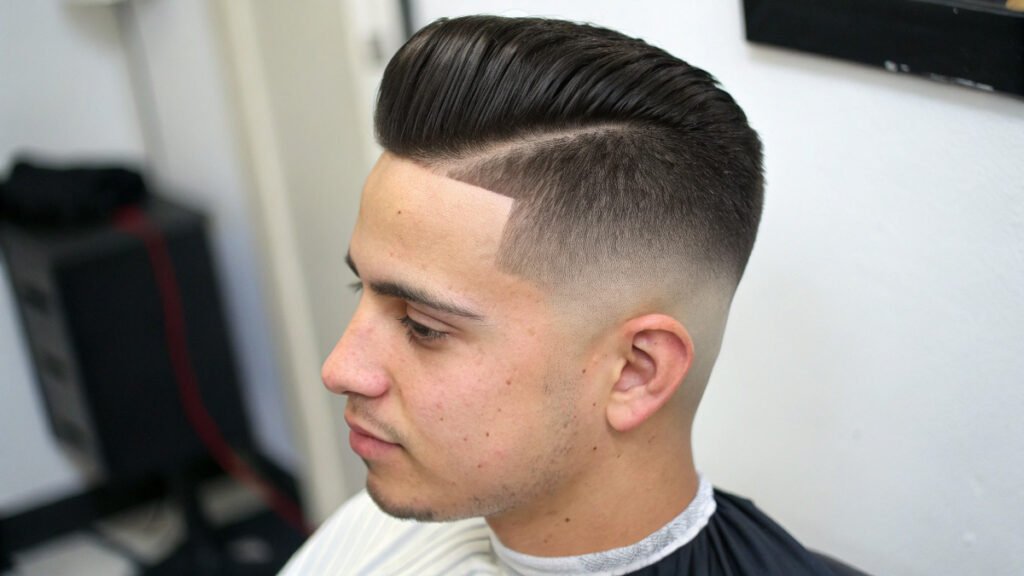
The low fade begins just above ear level for subtle transitions. This placement creates professional appearances suitable for business environments. New fade clients often choose this option for its conservative approach.
The transition occurs lower on the head than other fade types. This positioning maintains more hair length on the sides. Business professionals prefer this style for its workplace appropriateness.
Styling Methods:
- Professional appearance: Apply pomade from roots to ends evenly
- Casual texture: Use sea salt spray for natural movement
- Compatible face shapes: Works with all facial structures
- Hair type suitability: Effective with straight, wavy, or curly textures
Professional advice: Request longer blending zones for extra subtlety
Mid Fade
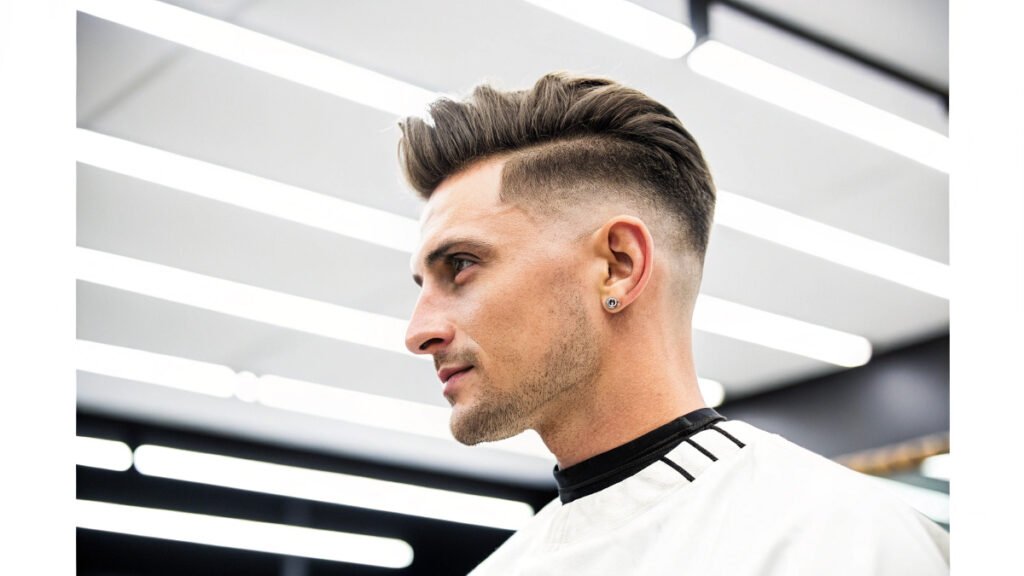
Mid fades start at temple level for balanced proportions. This placement offers versatility between conservative and modern styles. The fade begins around the middle section of your head’s sides.
This positioning creates moderate contrast without dramatic changes. Many clients choose mid fades for their adaptable nature. The style works well with various hair lengths on top.
Styling Approaches:
- Sharp definition: Use medium-hold gel with precision combing
- Natural movement: Apply light pomade using finger techniques
- Suitable faces: Square, oval, and diamond shapes
- Hair compatibility: All textures respond well
Expert recommendation: Maintain longer top sections for styling versatility
High Fade
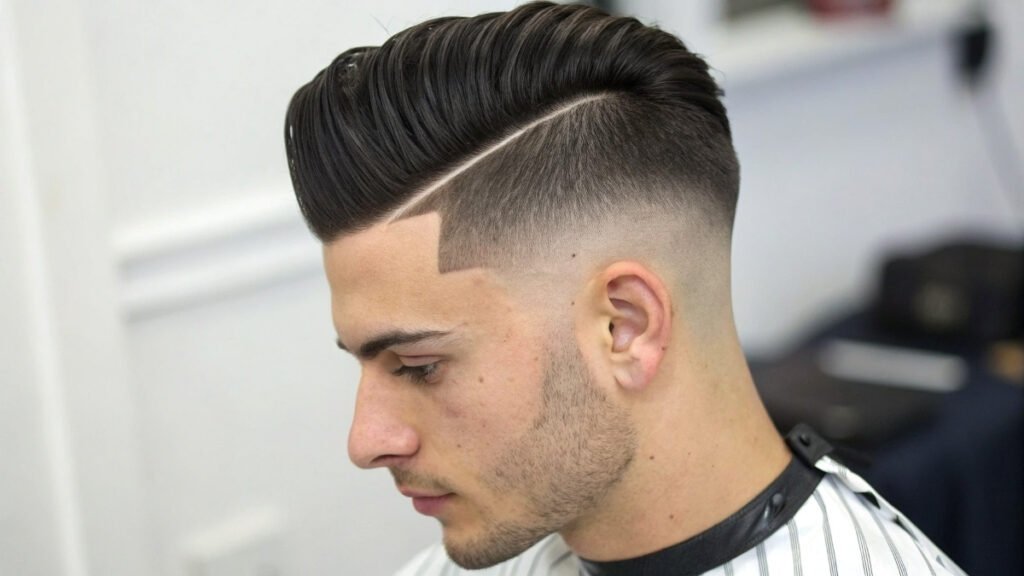
High fades begin near the crown area for bold contrast. This placement creates striking visual impact and modern appeal. The fade starts high on the sides and back sections.
Bold clients choose high fades for their dramatic effect. This style leaves significant length on top for creativity. The contrast between top and sides appears more pronounced.
Styling Options:
- Modern structure: Use strong-hold matte products for definition
- Sleek finish: Apply shine pomade with careful combing
- Face compatibility: Round, oval, and heart shapes
- Texture suitability: All hair types work effectively
Maintenance tip: Schedule appointments every 2-3 weeks for crispness
Low Taper Fade
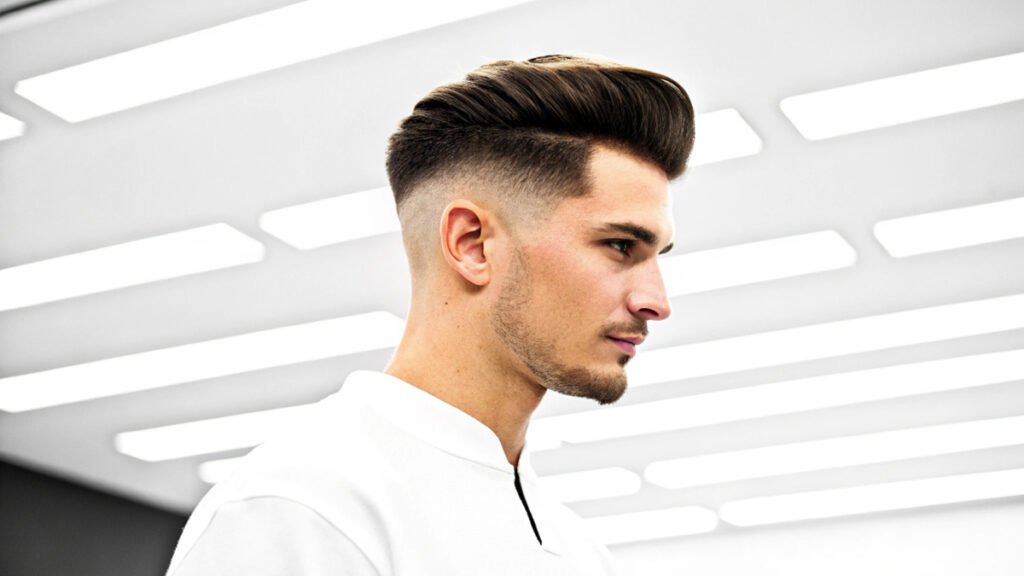
This style combines taper techniques with fade principles. The cut maintains more length while gradually shortening toward bottom. Professional clients often request this sophisticated option.
The low taper fade offers refined appearances without dramatic contrast. This approach suits conservative environments perfectly. The gradual reduction creates elegant transitions.
Application Methods:
- Business polish: Use light-hold cream with neat combing
- Relaxed texture: Apply sea salt spray for natural feel
- Universal face compatibility: Suits all facial structures
- Hair type range: Straight to wavy textures work best
Styling tip: Communicate longer preferences to your barber clearly
Mid-Taper Fade
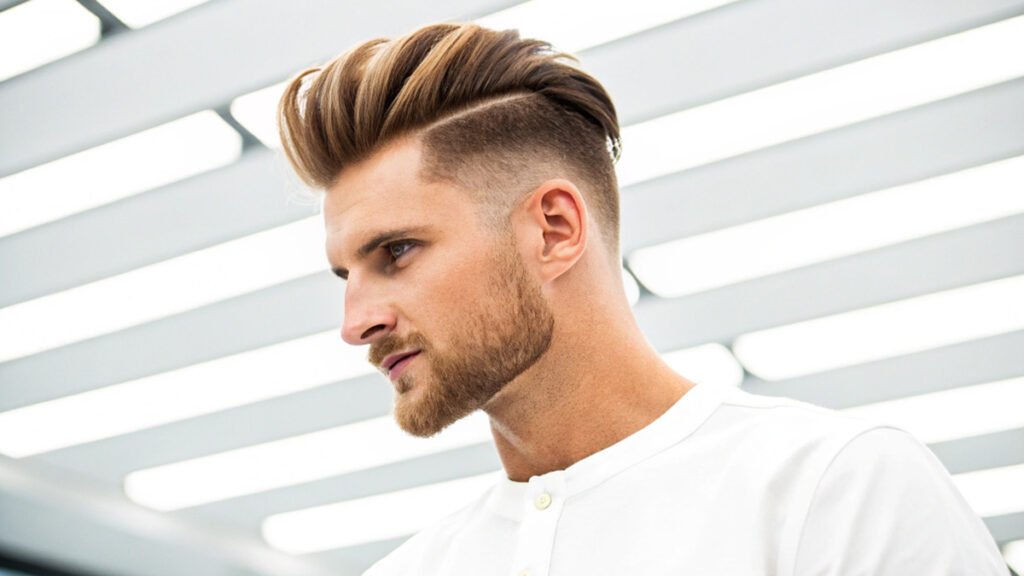
Mid-taper fades start at temple level with gradual shortening. This style bridges conservative and contemporary approaches effectively. The tapering process begins at the middle head section.
Clients appreciate the balance between professional and modern aesthetics. This option provides clean appearances without extreme contrast. The style offers excellent versatility for different occasions.
Styling Techniques:
- Polished results: Use medium-hold cream with precise combing
- Textured finish: Apply clay products using finger methods
- Face shape compatibility: Oval, square, and diamond structures
- Hair suitability: All types, particularly effective with thick textures
Professional note: Request scissors over clippers for softer blending
High Taper Fade
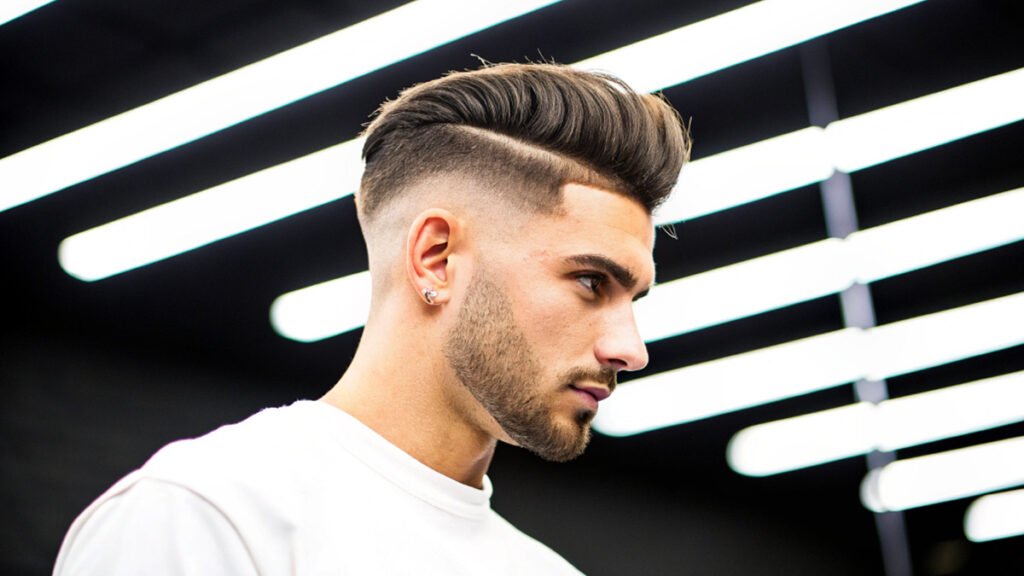
High taper fades begin near the crown with maintained length. This style creates height while preserving polished appearances. The taper starts high but keeps more hair than regular high fades.
Clients seeking drama with sophistication choose this option. The style offers structure while maintaining professional appeal. Height and definition combine effectively in this cut.
Styling Applications:
- Classic elegance: Brush back using medium-hold pomade
- Contemporary texture: Use matte paste for height and definition
- Compatible faces: Round, oval, and heart shapes
- Hair type effectiveness: All textures respond positively
Expert advice: Maintain three inches minimum on top for optimal styling
Drop Fade
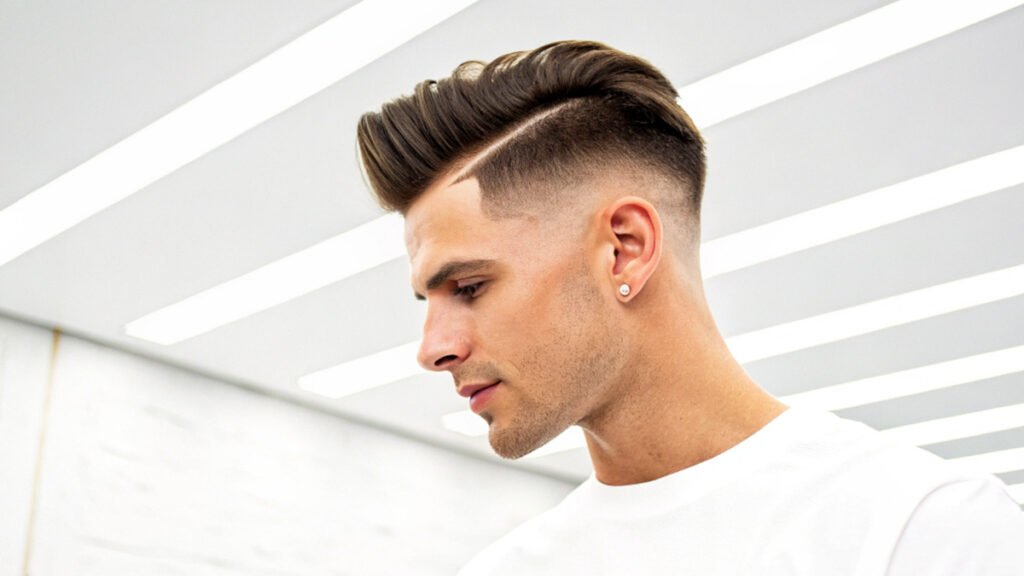
Drop fades curve behind ears following natural head contours. This unique shape adds personality while maintaining clean lines. The fade “drops” down behind ear areas creating distinctive arcs.
Creative clients appreciate the artistic nature of drop fades. This style adds visual interest to standard fade approaches. The curved line creates flattering effects for many face shapes.
Styling Methods:
- Sharp definition: Use strong-hold gel for precise lines
- Casual movement: Apply light cream for natural flow
- Face compatibility: All shapes, especially beneficial for long faces
- Hair texture range: Straight to wavy hair works effectively
Important note: Show reference photos for accurate curve placement
Temp Fade
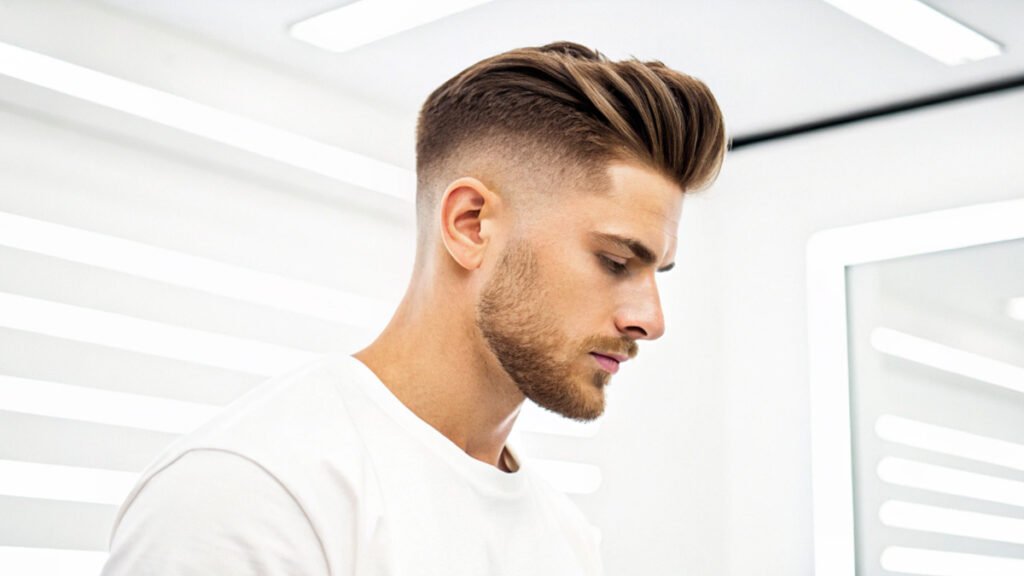
Temple fades focus exclusively on temple area cleanup. This subtle approach sharpens overall appearances without major changes. The fade concentrates on temple sections while preserving other areas.
Clients wanting minimal changes often choose temple fades. This option enhances existing styles without dramatic alterations. The focused approach creates clean, sharp temple lines.
Application Techniques:
- Clean finish: Use light pomade for subtle shine
- Natural texture: Apply salt spray for movement
- Universal compatibility: Suits all face shapes
- Hair type flexibility: Effective with all textures
Maintenance schedule: Touch-ups every two weeks maintain crispness
Fade Style Classifications
Skin Fade
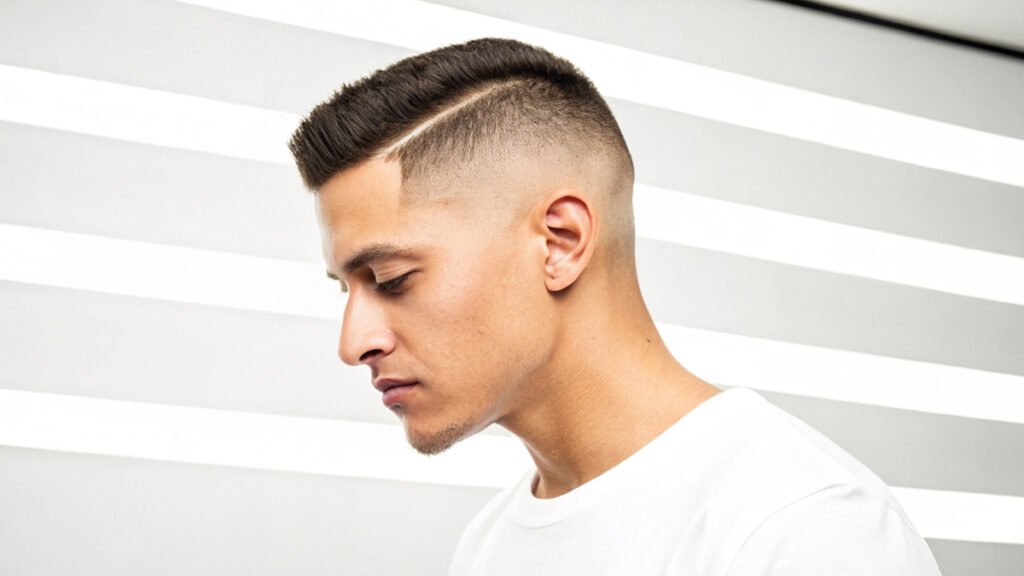
Skin fades transition completely to scalp level for maximum contrast. This dramatic approach creates bold visual impact. The fade reduces hair to skin level at the bottom sections.
Bold clients choose skin fades for their striking appearance. This style offers the highest contrast between top and sides. The clean scalp creates sharp definition lines.
Styling Approaches:
- Sleek elegance: Use high-shine pomade for polished results
- Textured contrast: Apply clay for matte finishes
- Face compatibility: Oval, square, and diamond shapes
- Hair suitability: All textures work effectively
Care tip: Moisturize faded areas to maintain healthy skin
Bald Fade
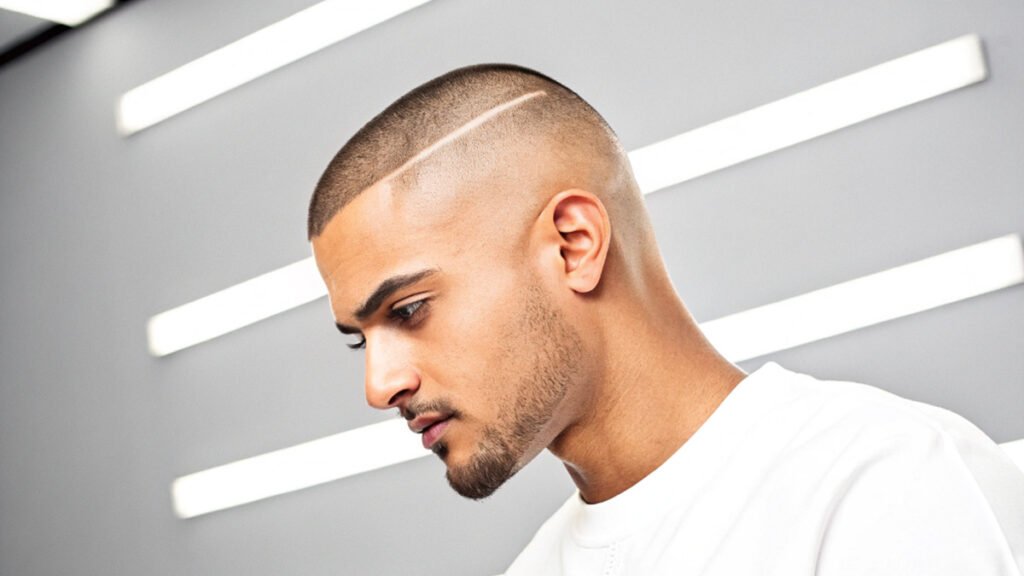
Bald fades often start higher with quicker transitions to skin. This creates even more dramatic contrast than skin fades. The rapid transition produces eye-catching effects.
Clients seeking maximum impact choose bald fades. This style makes strong fashion statements. The contrast between full top and bald sides appears striking.
Styling Options:
- Bold contrast: Use strong-hold products for definition
- Smooth finish: Apply shine pomade with careful combing
- Compatible faces: Round, oval, and heart shapes
- Texture range: All hair types respond well
Scheduling note: Plan maintenance every 1-2 weeks
Taper Fade
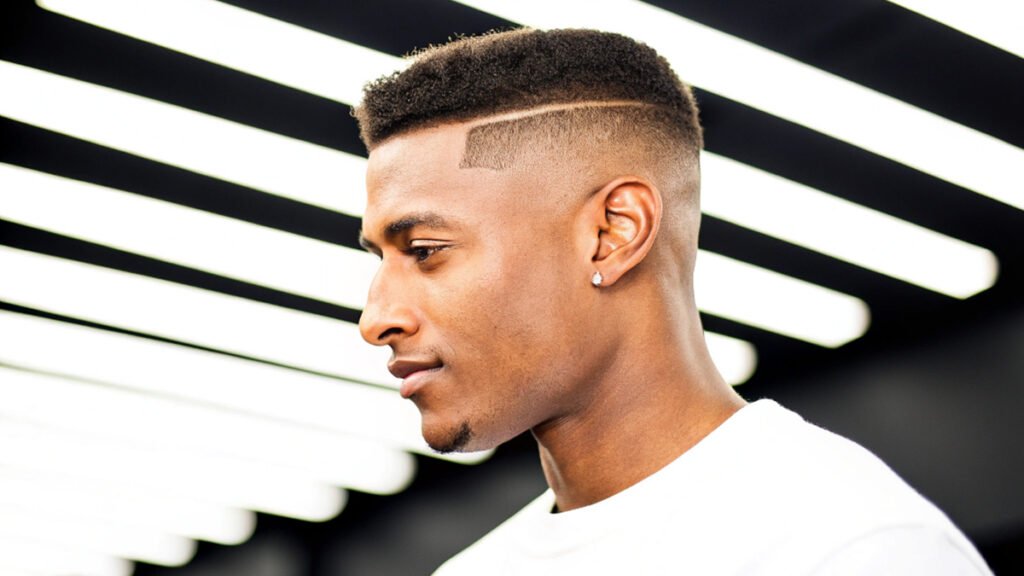
Classic taper fades provide clean transitions without skin exposure. This approach maintains some length throughout the fade. The style offers clean appearances with gentler contrast.
Professional environments often prefer taper fades. This option looks fresh while feeling familiar. The graduated length creates smooth visual flow.
Application Methods:
- Business appropriate: Use light-hold cream with neat styling
- Casual texture: Apply texture spray for natural movement
- Universal face compatibility: Effective for all structures
- Hair type suitability: Straight to wavy textures work best
Communication tip: Specify desired fade starting points clearly
Shadow Fade
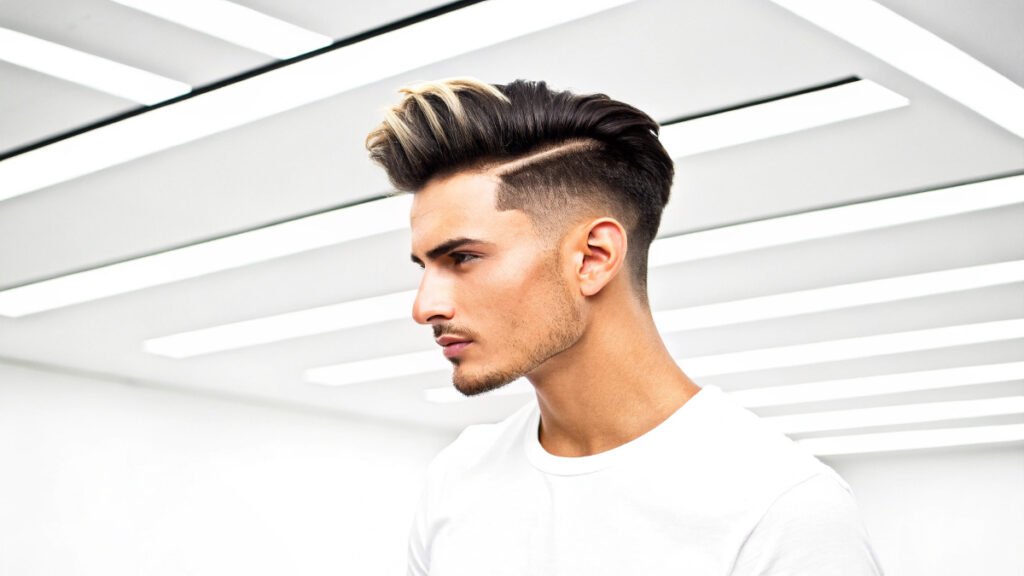
Shadow fades create subtle gradations with soft contrast. This technique produces darker-to-lighter effects without harsh lines. The approach emphasizes texture over dramatic length changes.
Clients preferring understated styles choose shadow fades. This option provides freshness without bold statements. The subtle gradation works well for conservative preferences.
Styling Techniques:
- Smooth application: Use light pomade for subtle enhancement
- Natural movement: Apply salt spray with scrunching motions
- Face compatibility: All shapes benefit
- Hair effectiveness: Works best with darker textures
Professional insight: Gradual blending requires skilled technique
Undercut Fade
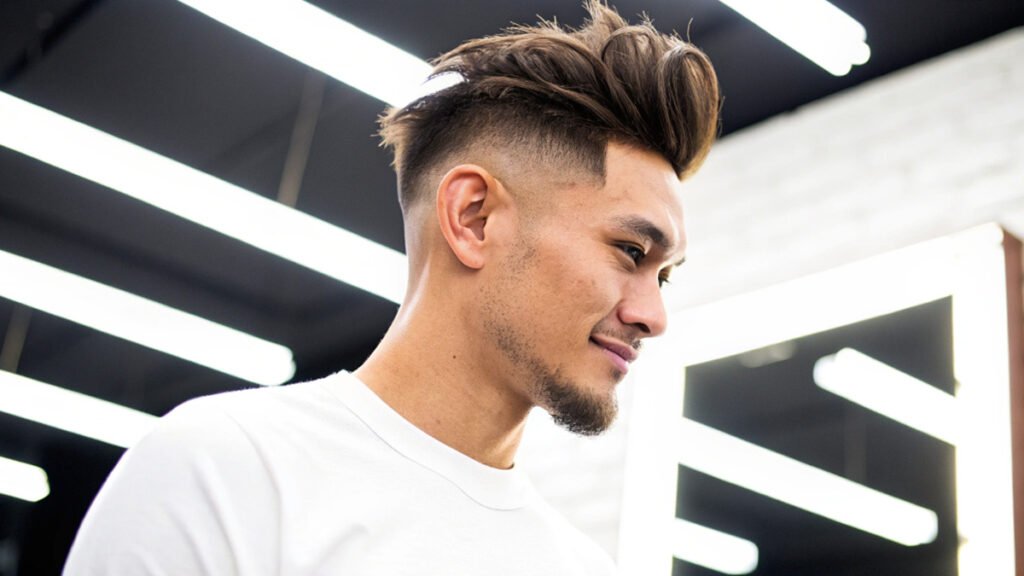
Undercut fades combine dramatic undercuts with fade techniques. The top remains long while sides transition smoothly. This style offers bold contrast with styling versatility.
Creative clients appreciate undercut fade combinations. This approach allows dramatic side contrast with top flexibility. The style suits various hair lengths and textures.
Styling Applications:
- Slick sophistication: Use strong-hold pomade for definition
- Messy creativity: Apply sea salt spray with clay products
- Compatible faces: Oval, square, and diamond shapes
- Hair requirements: Straight to wavy textures work best
Length recommendation: Maintain four inches minimum on top
Burst Fade
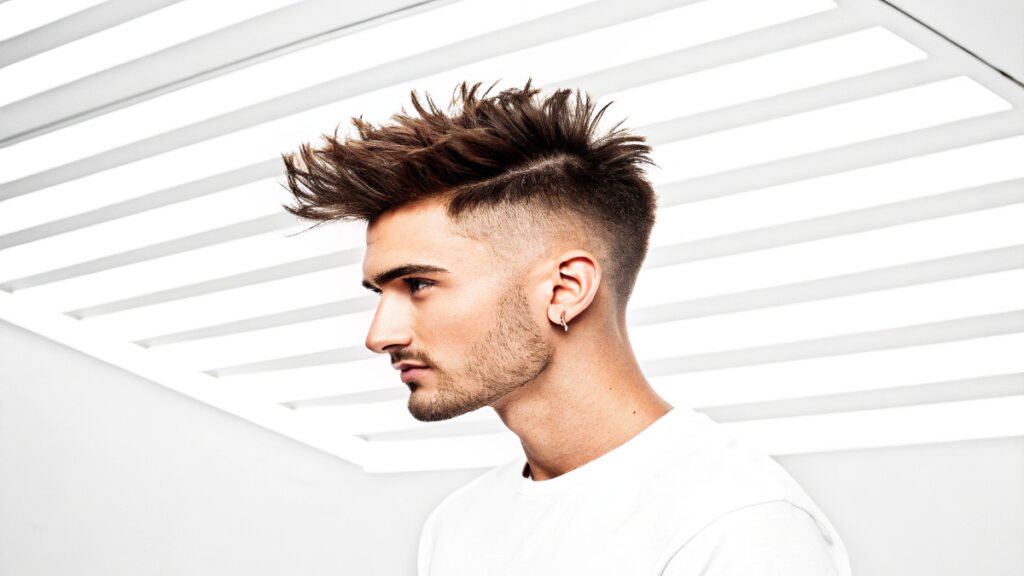
Burst fades radiate from behind ears like sunburst patterns. This circular approach creates unique visual effects. The fade spreads outward rather than following traditional straight lines.
Artistic clients choose burst fades for their creativity. This style adds personality to standard approaches. The radiating pattern creates distinctive appearances.
Styling Methods:
- Sharp definition: Use medium-hold gel for structure
- Soft texture: Apply light cream for natural feel
- Face compatibility: Round, oval, and heart shapes
- Hair suitability: All textures respond effectively
Placement importance: Ear positioning affects overall pattern success
Gloomy Fade
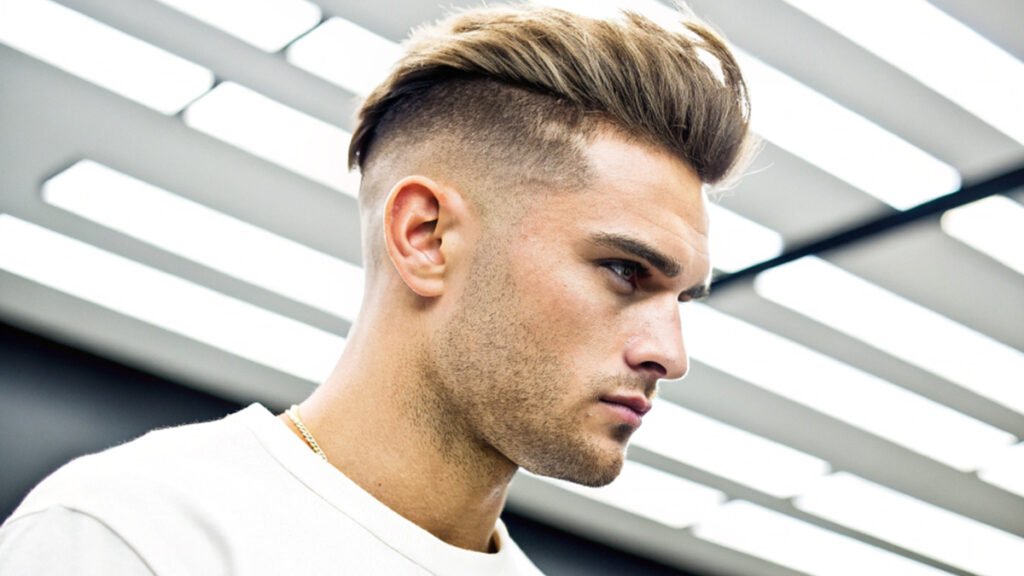
Gloomy fades maintain darker tones throughout transitions. This approach emphasizes texture over contrast. The style creates mysterious, subtle effects.
Clients preferring understated drama choose gloomy fades. This option provides interest without bright contrast. The darker gradation suits various hair colors.
Application Techniques:
- Matte finish: Use clay products for texture enhancement
- Subtle shine: Apply low-shine pomade sparingly
- Universal compatibility: Suits all face shapes
- Hair effectiveness: Dark textures show best results
Styling note: Textured cutting enhances overall effects
Hair Type and Style Combinations
Curly Fade
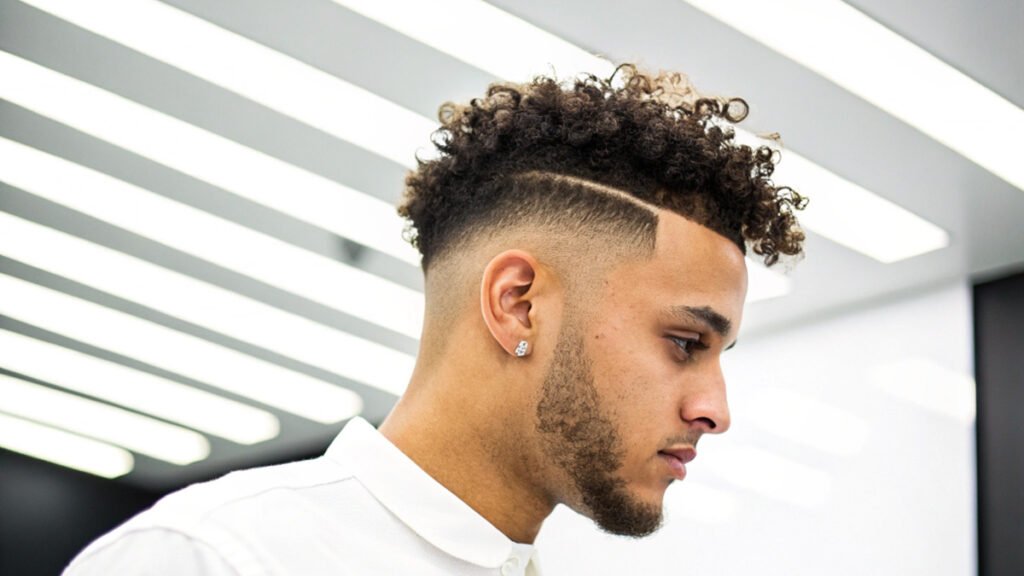
Curly fades preserve natural curl patterns while cleaning side sections. This approach celebrates texture while maintaining neat appearances. The contrast between curly top and faded sides creates appeal.
Clients with natural curls appreciate this style’s balance. The approach manages volume while showcasing texture. Clean sides help curls appear more defined.
Styling Applications:
- Defined curls: Use curl cream with scrunching techniques
- Natural shine: Apply light oil for healthy appearance
- Face compatibility: All shapes work well
- Hair requirements: Natural curl patterns
Care tip: Style when wet for best curl definition
Afro Taper
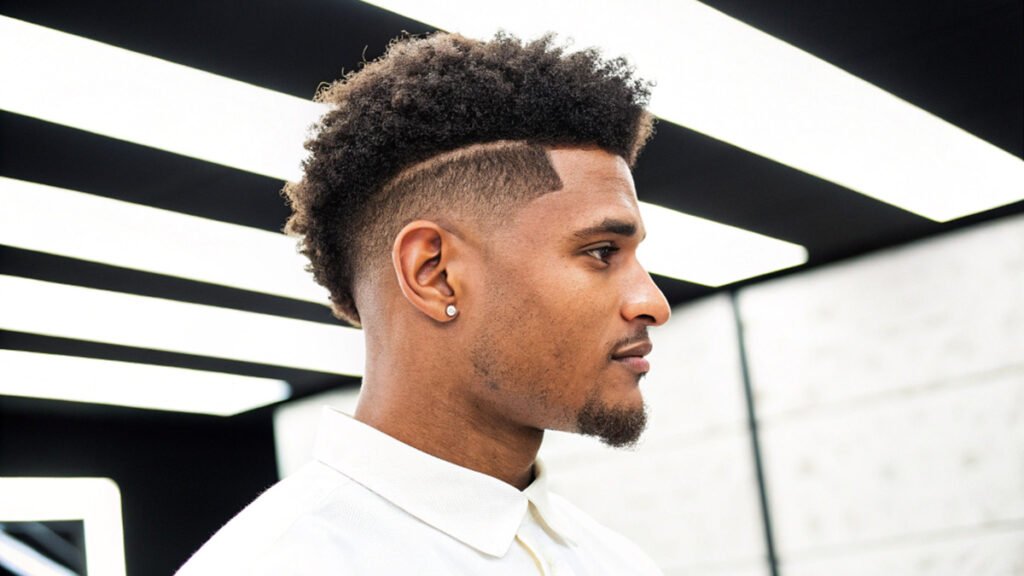
Afro tapers maintain natural volume while adding clean graduation. This style respects texture while creating contemporary appeal. The taper manages sides without eliminating character.
Clients with type 4 hair often prefer this approach. The style provides freshness while honoring natural texture. Clean lines enhance overall shape.
Styling Methods:
- Enhanced definition: Use curl-enhancing cream products
- Natural maintenance: Apply light oil with pick styling
- Universal face compatibility: Suits all shapes
- Hair specificity: Type 4 textures work best
Tool recommendation: Use picks for optimal shape creation
Afro Fade
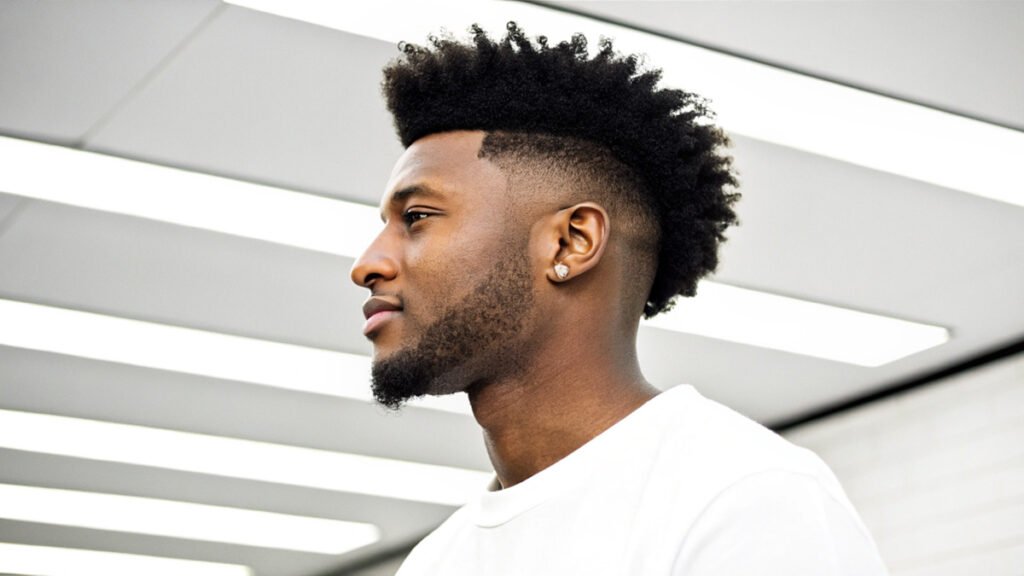
Afro fades combine full natural texture with sharp side contrast. This bold approach showcases texture dramatically. The contrast makes natural patterns more prominent.
Creative clients appreciate this style’s impact. The approach celebrates natural hair while adding contemporary edges. Clean sides frame textured tops effectively.
Application Techniques:
- Shape definition: Use curl cream with pick styling
- Natural moisture: Apply light oil for health
- Face compatibility: All shapes benefit
- Hair requirements: Type 4 textures essential
Maintenance schedule: Regular shape-ups preserve clean lines
Curly Fluffy + Fade
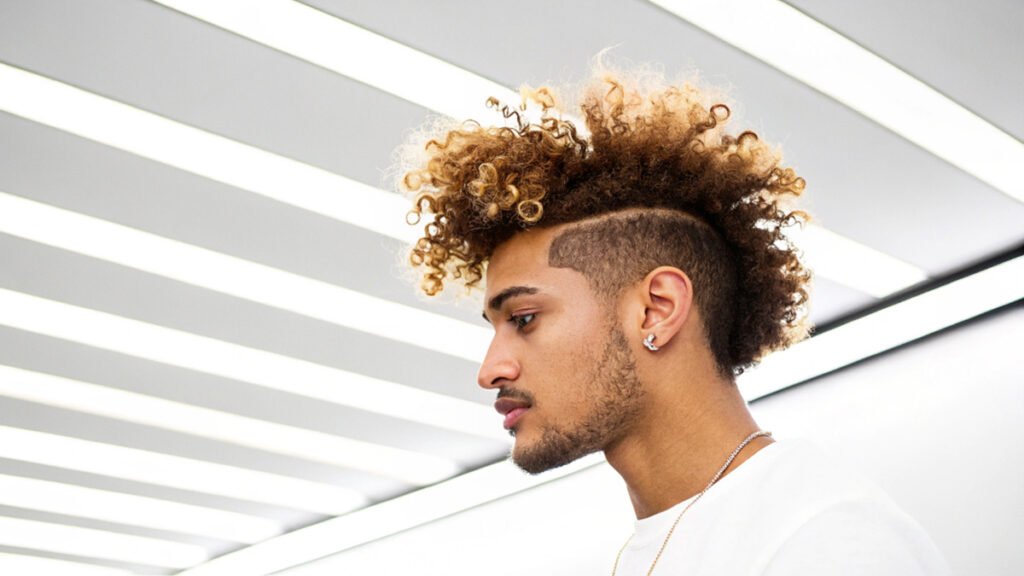
This style maintains curl volume with loose, fluffy textures. The fade manages side volume while tops remain bouncy. Playful yet clean appearances result from this combination.
Clients wanting fun styles choose this option. The approach balances volume control with texture celebration. Clean sides make fluffy tops more prominent.
Styling Options:
- Light definition: Use lightweight curl cream sparingly
- Volume enhancement: Apply mousse for bounce
- Face compatibility: All shapes work effectively
- Hair suitability: Wavy to curly textures
Drying tip: Use diffusers for maximum fluff preservation
Curly Taper Fade
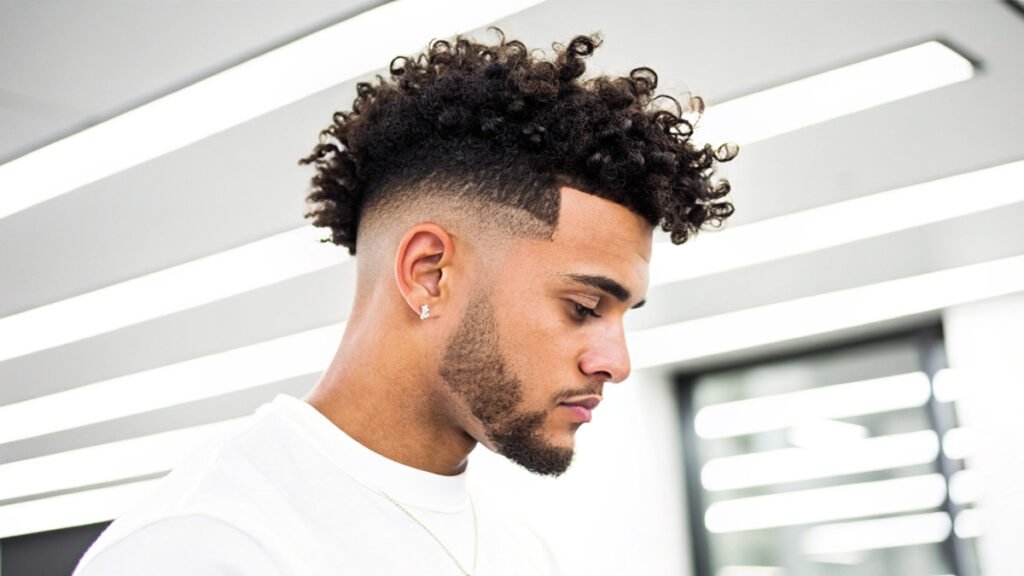
Curly taper fades soften traditional fade approaches for curl compatibility. This style maintains some texture throughout while managing overall volume. The gradual approach respects natural patterns.
Clients preferring gentler contrast choose this style. The approach manages curls without eliminating character completely. Gradual transitions work well with natural textures.
Styling Applications:
- Curl definition: Use curl-defining cream products
- Natural hold: Apply light-hold mousse for support
- Universal compatibility: All face shapes work
- Hair specificity: Curly textures essential
Wet styling: Apply products to very wet hair for best results
Hairstyle Combination Categories
Slick High Fade
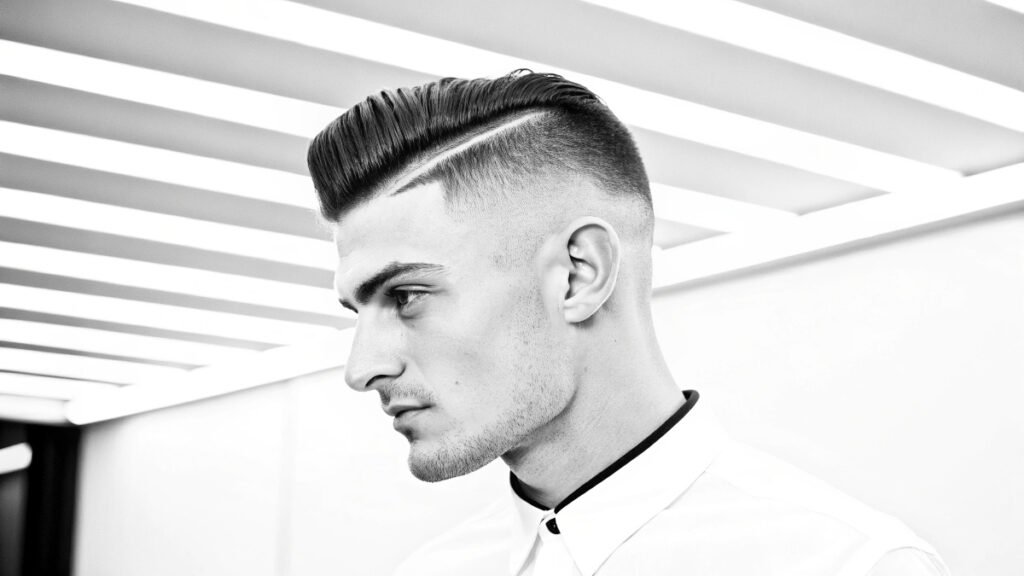
Slick high fades pair sharp fades with smooth, polished tops. This combination creates classic elegance with modern edges. The contrast between sleek top and clean sides appears sophisticated.
Professional clients often choose this refined approach. The style suits formal occasions perfectly. Clean lines and smooth textures create timeless appeal.
Styling Methods:
- High polish: Use glossy pomade with careful combing
- Modern approach: Apply medium-hold cream for updated looks
- Compatible faces: Square, oval, and diamond shapes
- Hair requirements: Straight to wavy textures work best
Technique tip: Blow dry while brushing back for optimal hold
Fade with Slicked-Back Hair
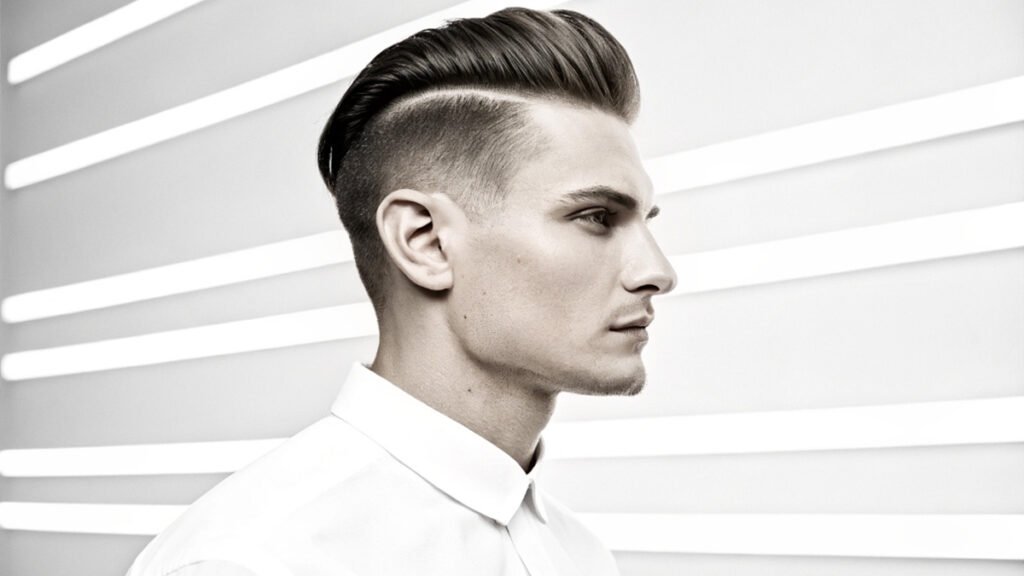
This relaxed version allows more styling flexibility than strict slick styles. The fade placement varies while tops remain sleekly styled. Versatility makes this option popular.
Clients wanting options choose this adaptable style. Professional settings and casual occasions both suit this approach. The flexibility accommodates different lifestyle needs.
Application Techniques:
- Professional polish: Use oil-based pomade for shine
- Casual elegance: Apply light-hold cream for softness
- Face compatibility: All shapes work effectively
- Hair suitability: Straight to wavy textures
Preparation note: Start with damp hair for better control
Fade with Slicked Side Part
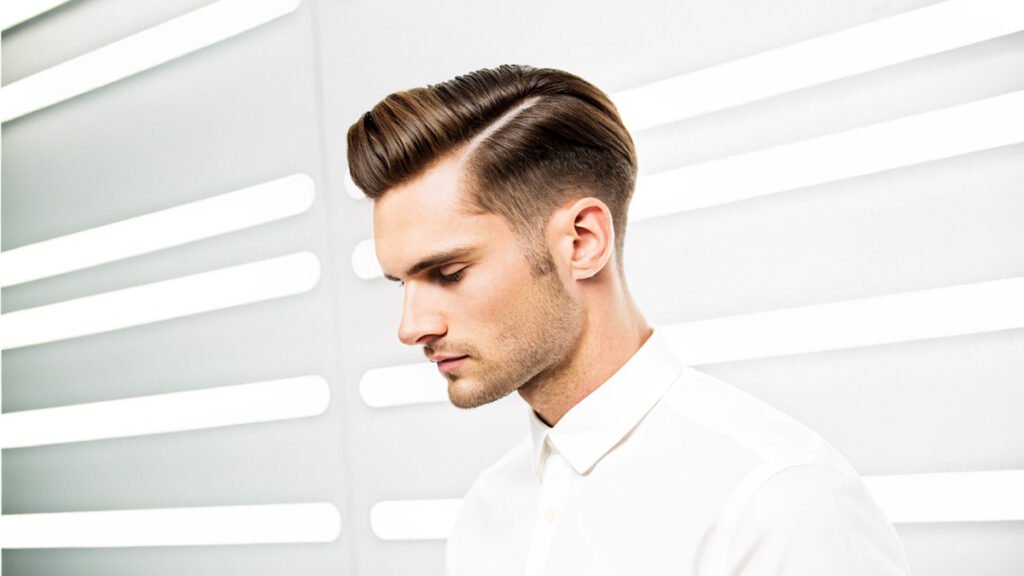
Classic side parts combine with modern fades for timeless appeal. This approach adds structure while maintaining contemporary edges. Sharp parts create definition and sophistication.
Business professionals appreciate this style’s versatility. The combination works in conservative and creative environments. Clean lines and classic proportions create lasting appeal.
Styling Options:
- Sharp precision: Use strong-hold pomade with fine combs
- Relaxed elegance: Apply medium-hold cream for softness
- Compatible faces: Oval, square, and diamond shapes
- Hair effectiveness: Straight textures show best results
Part creation: Use combs for sharp, defined part lines
Fade with Side Swept Hair
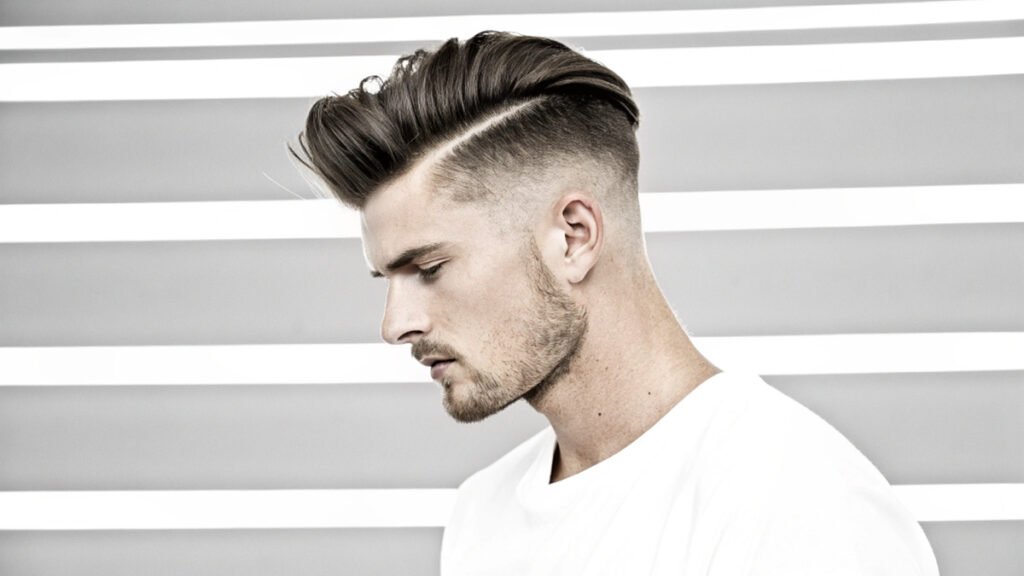
Side-swept styles offer natural movement with clean fade contrast. This approach creates casual sophistication without rigid structure. Hair flows naturally while sides remain crisp.
Clients preferring natural movement choose this option. The style accommodates active lifestyles while maintaining polished appearances. Casual elegance results from this combination.
Styling Applications:
- Natural flow: Use light-hold cream for movement
- Textured interest: Apply sea salt spray for casual texture
- Face compatibility: Round, oval, and heart shapes
- Hair range: All textures respond positively
Direction tip: Blow dry in desired hair flow direction
Fade with Flat Top
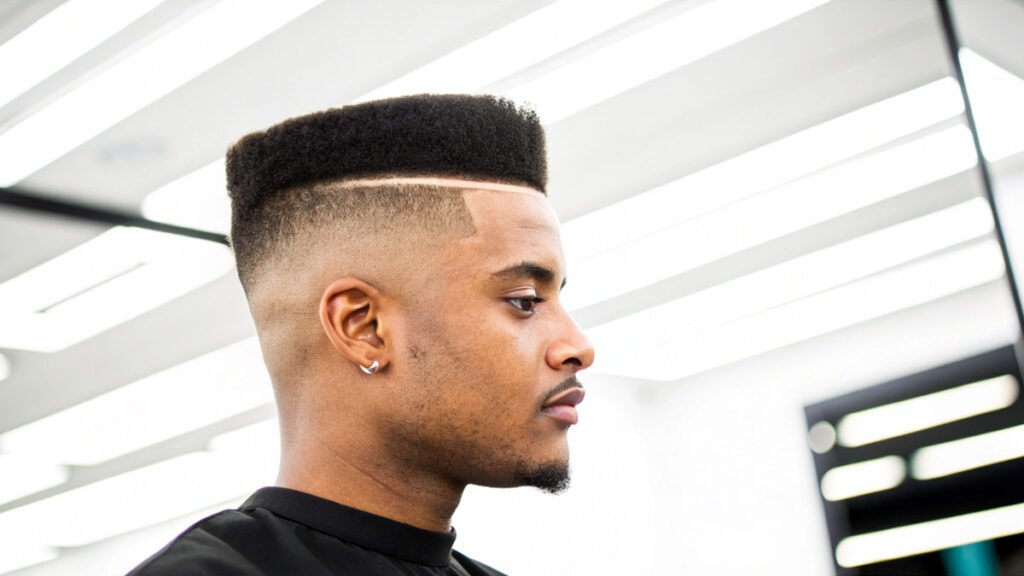
Flat top fades create geometric precision with architectural appeal. This bold approach emphasizes clean lines and perfect angles. The contrast between flat top and faded sides appears striking.
Clients seeking distinctive styles choose flat tops. This approach makes strong visual statements. Clean geometry and precise lines create memorable appearances.
Styling Methods:
- Classic precision: Use strong-hold gel for structure
- Modern approach: Apply matte paste for updated finishes
- Compatible faces: Oval and diamond shapes
- Hair requirements: Straight to wavy textures work best
Maintenance importance: Schedule cuts every two weeks for precision
Fade with Sponge Twists
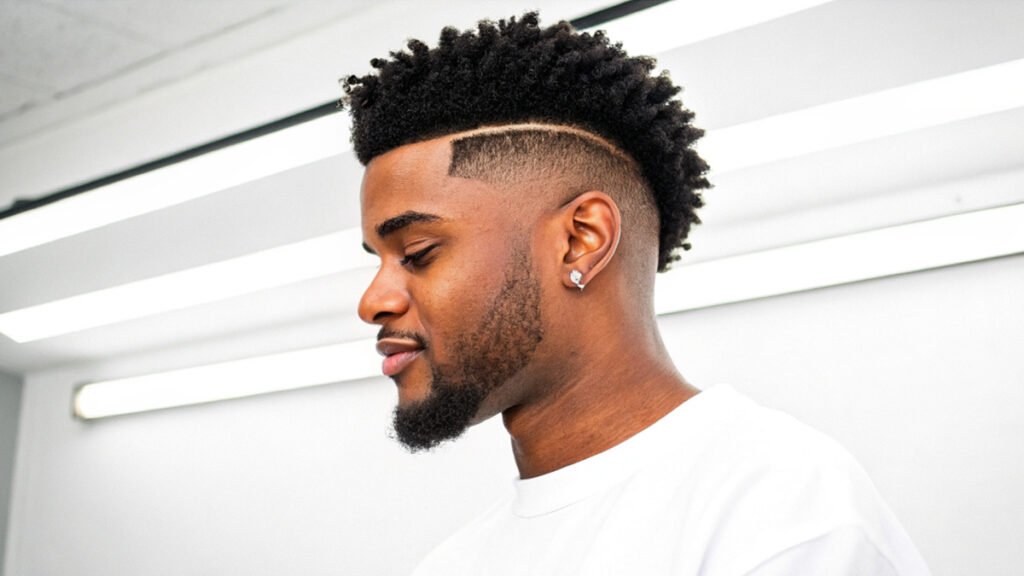
Sponge twist techniques create textured patterns with fade contrast. This approach adds visual interest through systematic twisting. The combination celebrates texture while maintaining clean sides.
Creative clients appreciate this style’s uniqueness. The approach combines texture art with contemporary fading. Clean sides frame textured patterns effectively.
Application Techniques:
- Pattern definition: Use twist-defining cream products
- Healthy moisture: Apply light oil for texture health
- Face compatibility: All shapes work well
- Hair specificity: Type 4 textures essential
Tool usage: Apply sponge techniques to damp hair
Fade with Caesar Cut
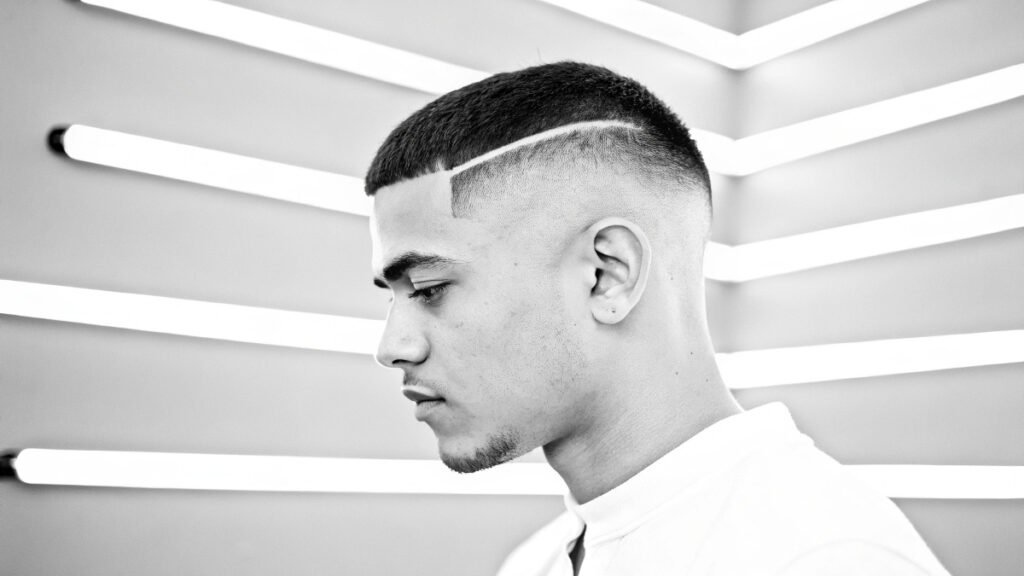
Caesar cuts maintain short, forward-styled tops with fade sides. This low-maintenance approach offers style without complexity. Clean sides enhance the classic Caesar shape.
Busy clients appreciate this style’s simplicity. The approach requires minimal daily styling while maintaining polished appearances. Classic proportions create timeless appeal.
Styling Options:
- Clean simplicity: Use light-hold cream for neat finish
- Textured interest: Apply matte clay for subtle definition
- Compatible faces: All except extremely long shapes
- Hair suitability: Straight to wavy textures
Length guideline: Maintain one-inch fringe length approximately
Fade with Dreadlocks
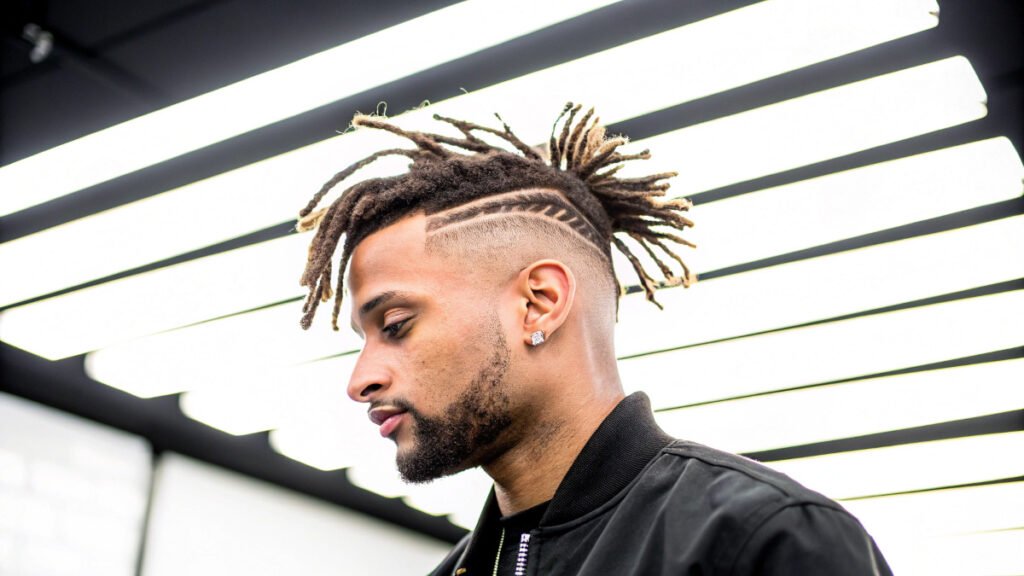
Dreadlock fades combine textured locs with clean side contrast. This approach manages loc volume while maintaining cultural authenticity. Clean sides frame natural textures beautifully.
Clients with locs appreciate this style’s balance. The approach celebrates natural texture while adding contemporary elements. Clean contrast enhances loc definition.
Styling Applications:
- Edge definition: Use loc gel for clean perimeters
- Natural health: Apply light oil for loc maintenance
- Face compatibility: All shapes benefit
- Hair flexibility: All textures can form locs
Maintenance schedule: Regular retwisting preserves loc definition
Fade with Dreads
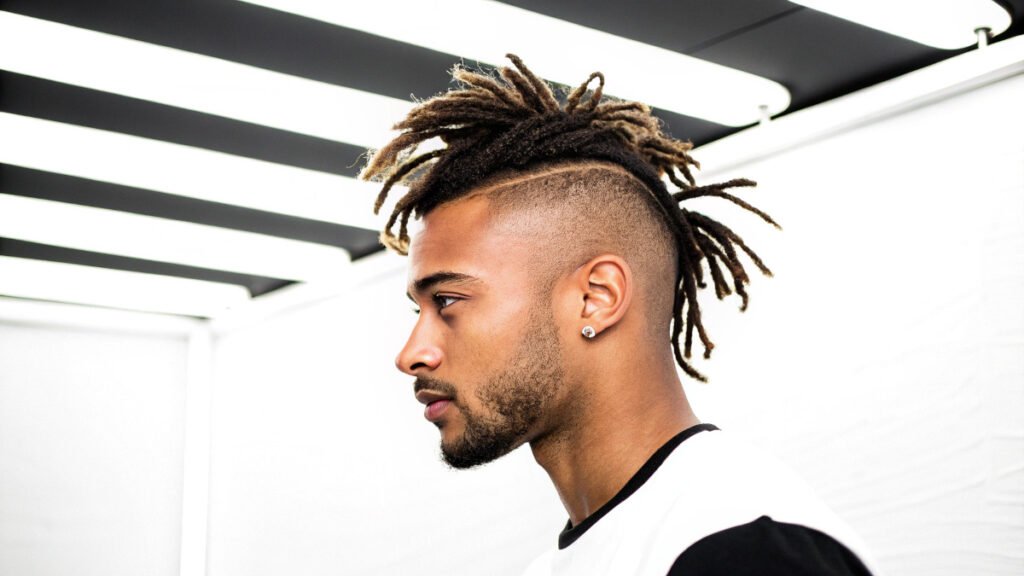
Similar to locs but featuring thinner formations, this style offers placement flexibility. The fade manages volume while allowing creative dread styling. Clean sides provide excellent contrast.
Creative clients choose this versatile option. The approach allows various dread arrangements while maintaining clean perimeters. Style flexibility accommodates personal preferences.
Styling Methods:
- Hold definition: Use light-hold gel for structure
- Natural care: Apply essential oils for health
- Universal compatibility: All face shapes work
- Hair requirements: All textures accommodate dreads
Scalp care: Maintain proper moisture for healthy scalp
Fade with Mohawk
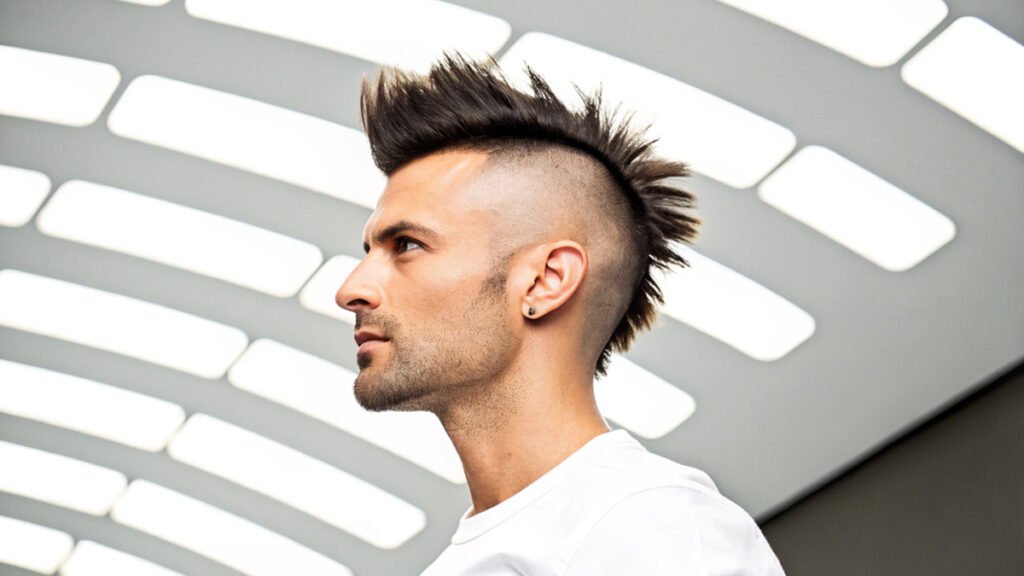
Mohawk fades create bold center strips with clean side contrast. This edgy approach makes strong style statements. The fade softens traditional mohawk intensity while maintaining impact.
Bold clients choose mohawks for their distinctive appeal. The approach creates dramatic effects without extreme maintenance. Clean sides balance bold center sections.
Application Techniques:
- Standing height: Use strong-hold gel for vertical structure
- Sleek laying: Apply pomade for smooth, flat styling
- Compatible faces: Long, oval, and diamond shapes
- Hair suitability: All textures work effectively
Height creation: Use blow dryers with strong-hold products
Fade with Quiff
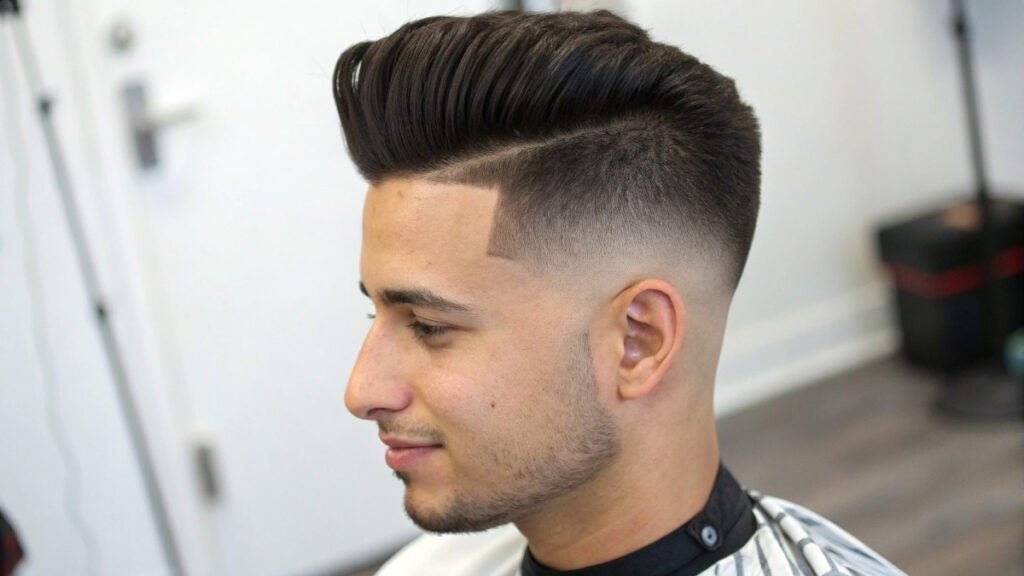
Quiff styles maintain volume and height while sides fade cleanly. This approach creates sophisticated elevation with contemporary edges. The combination appears both classic and current.
Style-conscious clients appreciate quiff versatility. The approach works for various occasions while maintaining visual interest. Volume and clean sides create appealing contrast.
Styling Options:
- Classic elevation: Use strong-hold pomade for traditional looks
- Modern texture: Apply volume powder with matte clay
- Compatible faces: Square, oval, and diamond shapes
- Hair requirements: Straight to wavy textures work best
Volume technique: Use round brushes with blow dryers
Fade with Faux Hawk
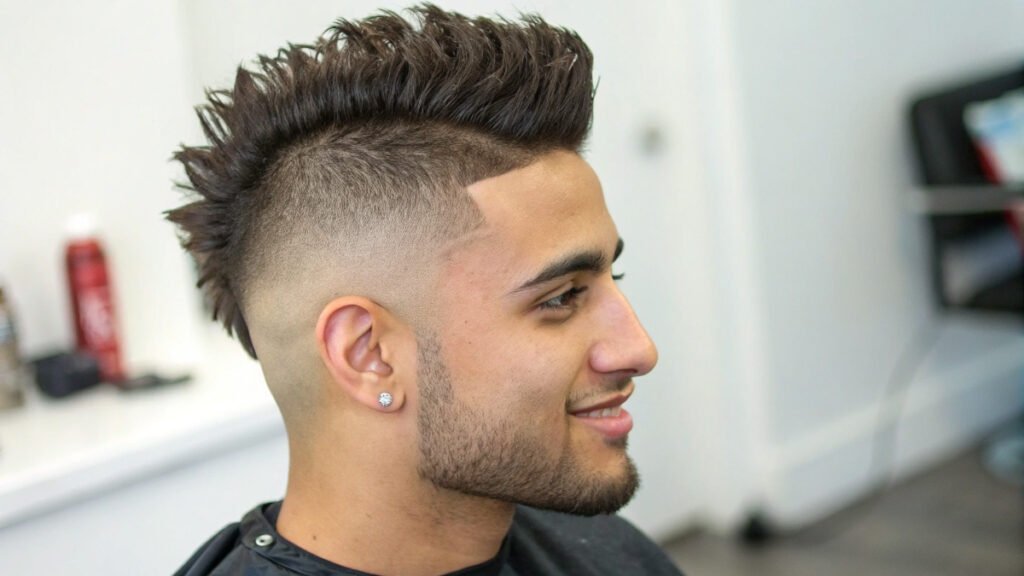
Faux hawks offer mohawk appeal with mainstream acceptability. This approach creates center interest while maintaining professional appropriateness. Clean fades soften overall intensity.
Clients wanting edge with flexibility choose faux hawks. The style provides boldness without extreme commitment. Clean sides balance center drama effectively.
Styling Applications:
- Defined spikes: Use strong-hold gel for structure
- Textured pieces: Apply clay for natural separation
- Face compatibility: All shapes work well
- Hair suitability: Straight to wavy textures
Direction tip: Style from back toward front for optimal shape
Fade with Spiky Hair
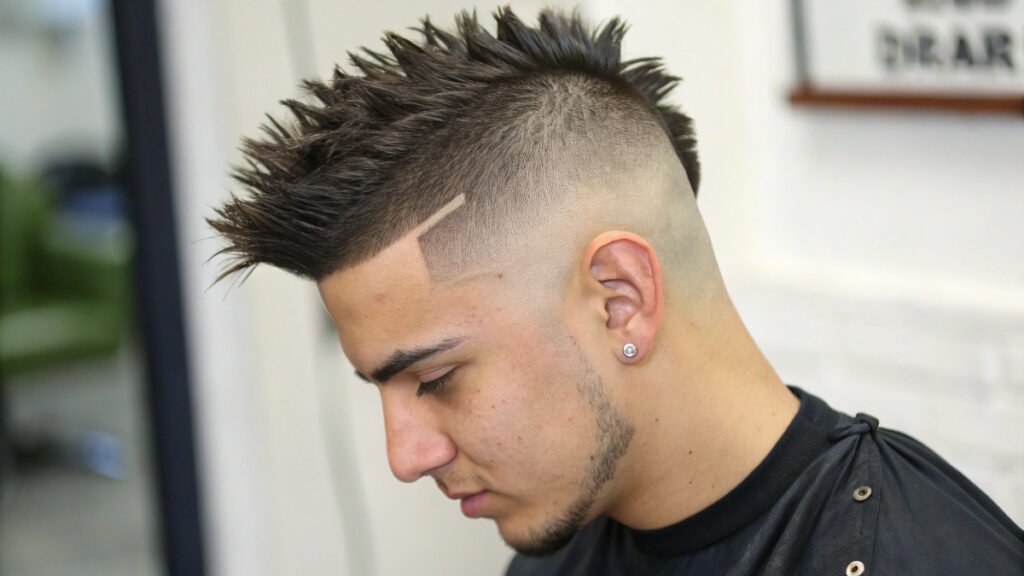
Spiky textures combine with clean fades for textural interest. This approach allows spike creativity while maintaining neat perimeters. The contrast enhances spiky definition.
Clients preferring texture choose this dynamic option. The approach provides visual interest through controlled chaos. Clean sides frame textured tops effectively.
Styling Methods:
- Sharp definition: Use strong-hold wax for precise spikes
- Soft texture: Apply texture paste for natural separation
- Compatible faces: Round, oval, and heart shapes
- Hair effectiveness: Straight textures work best
Application technique: Use fingers for natural-looking spike creation
Fade with French Crop
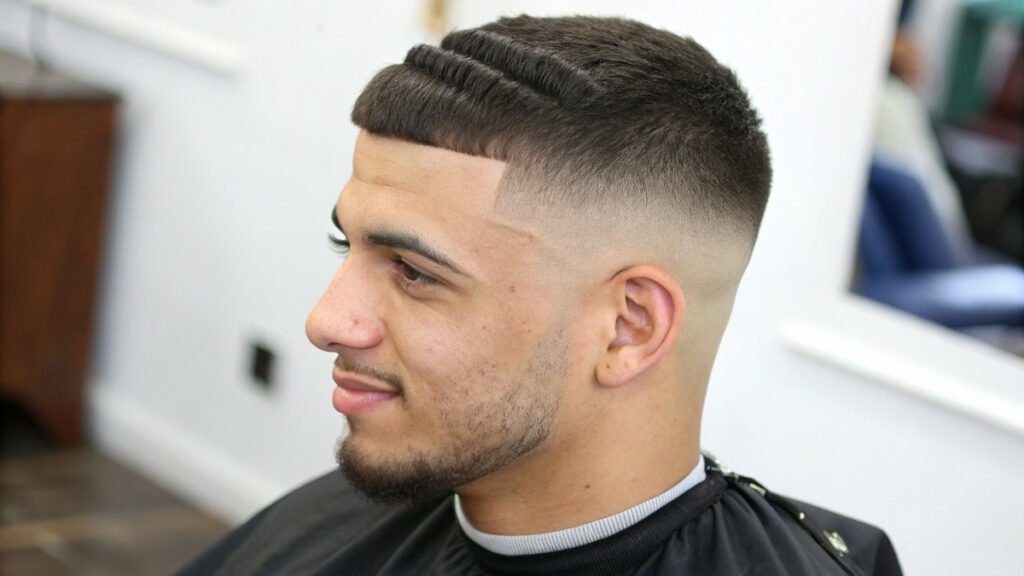
French crops maintain longer fringes with textured styling. This approach offers Caesar evolution with contemporary fading. Clean sides enhance the cropped appearance.
Modern clients appreciate this style’s sophistication. The approach provides low maintenance with high style impact. Natural texture and clean lines create current appeal.
Application Techniques:
- Clean definition: Use matte clay for subtle structure
- Casual texture: Apply sea salt spray for natural movement
- Universal compatibility: All face shapes work
- Hair range: All textures respond positively
Fringe tip: Point-cut fringes for natural texture enhancement
Fade with Pomp
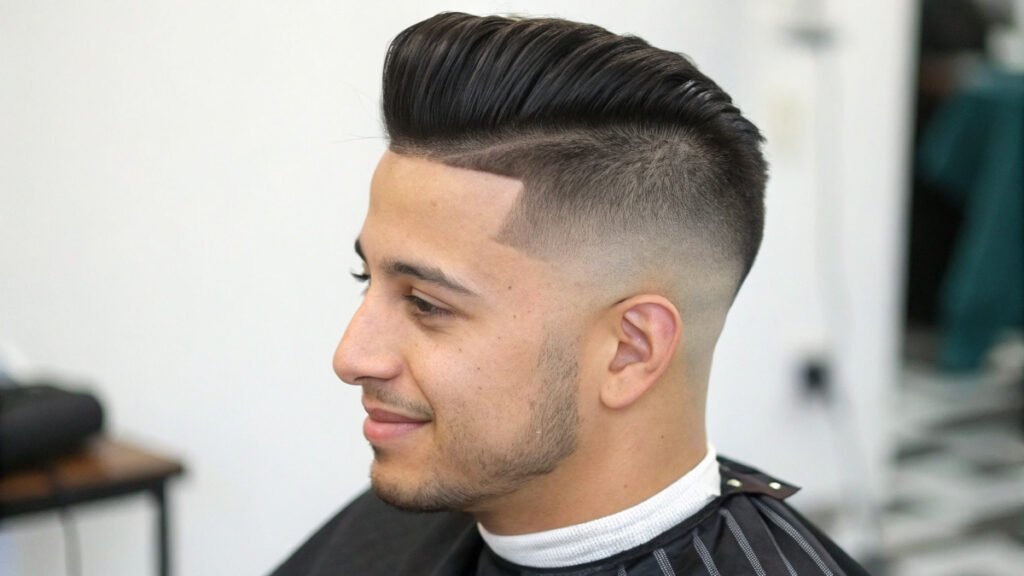
Pompadour fades combine classic height with modern side treatment. This approach creates timeless elegance with contemporary edges. The contrast between full pomp and clean sides appears striking.
Clients appreciating classic styles choose pompadours. The approach suits formal and casual occasions equally. Height and clean lines create sophisticated appearances.
Styling Options:
- Traditional shine: Use oil-based pomade for classic results
- Modern matte: Apply matte pomade for updated finishes
- Compatible faces: Oval, square, and diamond shapes
- Hair requirements: Straight to wavy textures work best
Volume creation: Use round brushes with hair dryers
Fade with Pomp Quiff
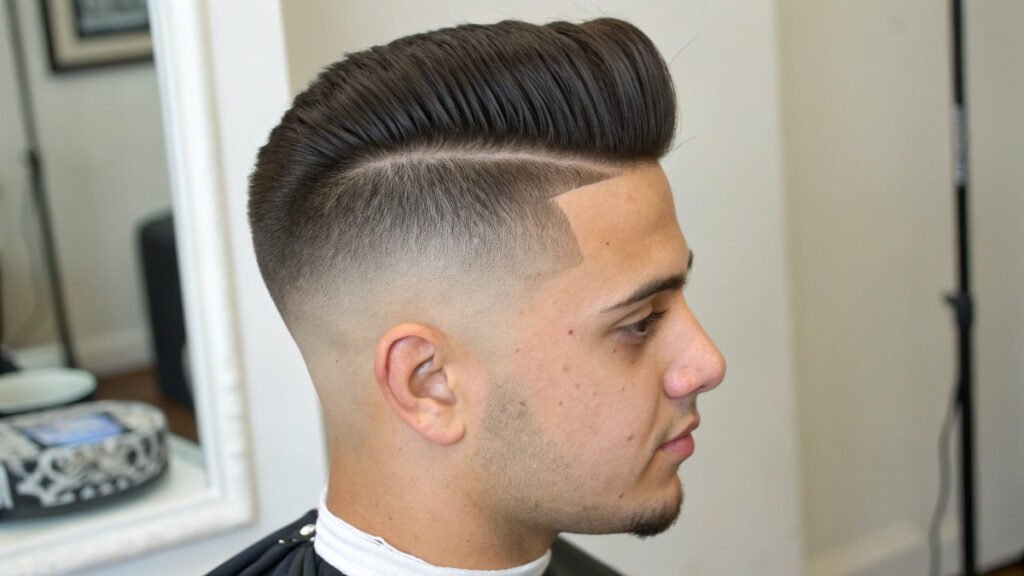
Pomp quiffs combine pompadour height with quiff wave motion. This advanced style creates sophisticated elevation with movement. Clean fades emphasize top volume dramatically.
Style enthusiasts choose this complex combination. The approach requires skill but creates impressive results. Height, movement, and clean sides produce striking effects.
Application Methods:
- Maximum volume: Use blow dry spray with strong-hold products
- Natural movement: Apply medium-hold cream for softness
- Compatible faces: All except round shapes
- Hair suitability: Straight to wavy textures
Volume tip: Blow dry opposite to growth direction
Fade with Tight Pomp
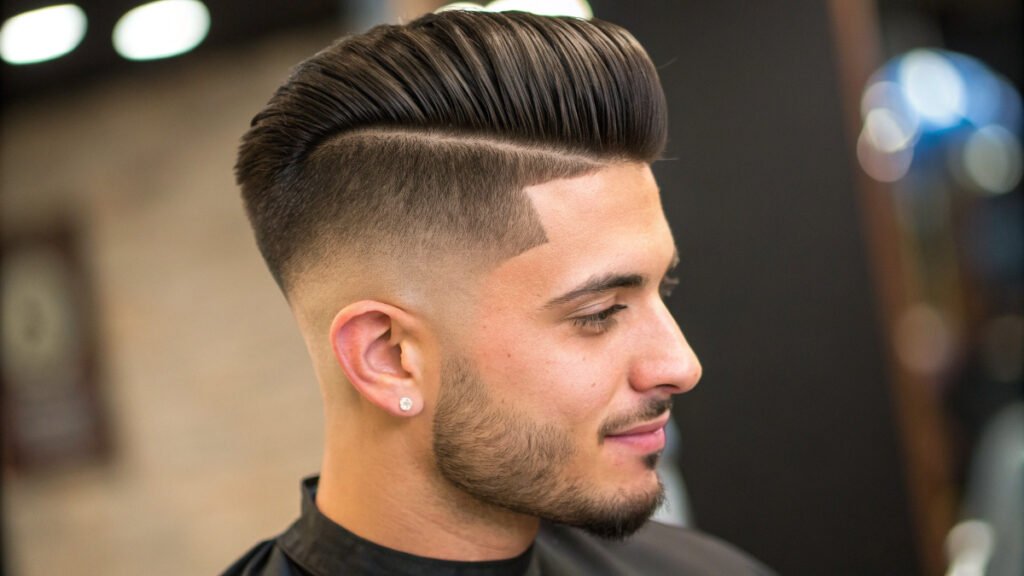
Tight pomps offer controlled precision with neat styling. This approach maintains pompadour structure with disciplined appearance. Clean fades complement precise top styling.
Professional clients prefer this controlled option. The approach suits conservative environments while maintaining style interest. Precision and cleanliness create polished results.
Styling Applications:
- High shine: Use glossy pomade for traditional appeal
- Matte precision: Apply strong-hold clay for modern looks
- Face compatibility: All shapes work effectively
- Hair effectiveness: Straight textures show best results
Precision tool: Use fine-toothed combs for exact styling
Fade with Angled Hair
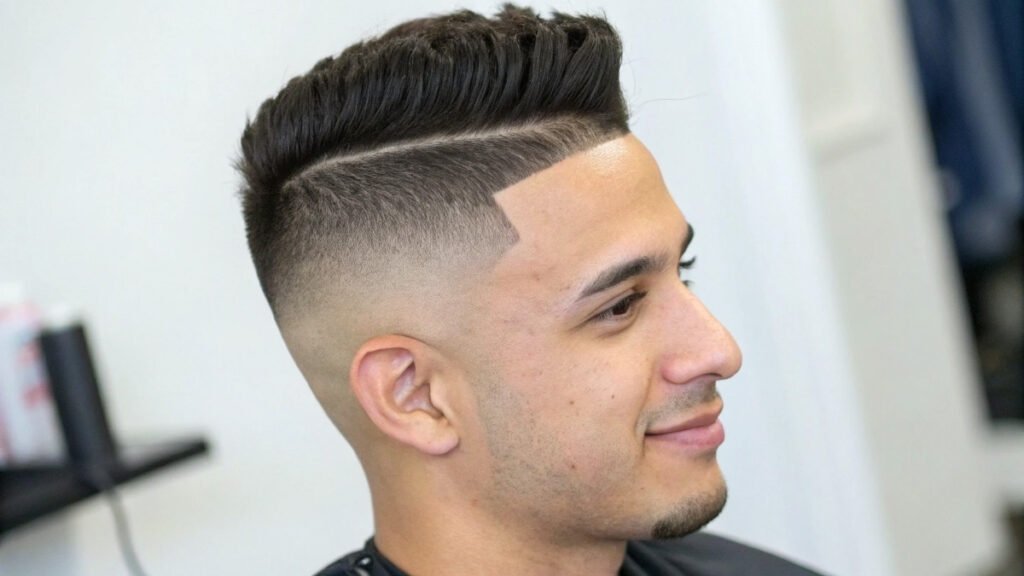
Angled styles create geometric patterns with architectural appeal. This approach emphasizes clean lines and precise angles. Fades complement geometric styling perfectly.
Clients appreciating modern design choose angled styles. The approach creates contemporary appearances through systematic cutting. Clean lines and fades work together harmoniously.
Styling Methods:
- Sharp precision: Use strong-hold pomade for definition
- Soft geometry: Apply light-hold cream for subtlety
- Compatible faces: Square, oval, and diamond shapes
- Hair requirements: Straight textures work best
Maintenance note: Use cutting scissors for angle preservation
Fade with Hard Part
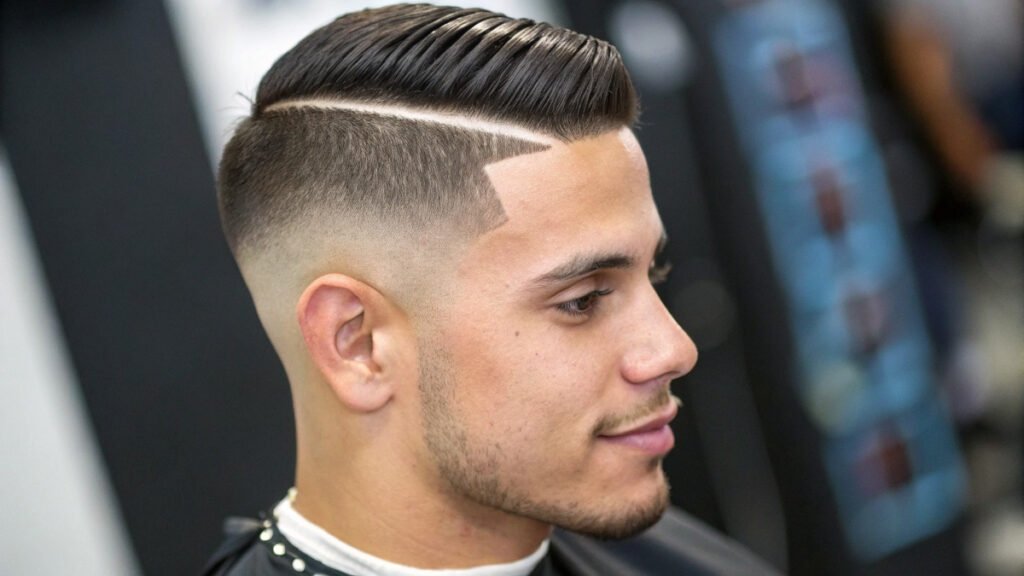
Hard parts feature shaved lines for ultimate precision. This approach combines dramatic part definition with clean fade contrast. Sharp lines create bold visual statements.
Bold clients choose hard parts for their impact. The approach makes strong style statements while maintaining professional acceptability. Precision and contrast create memorable appearances.
Application Techniques:
- Clean definition: Use medium-shine pomade for enhancement
- Casual approach: Apply light-hold cream for natural results
- Universal compatibility: All face shapes work
- Hair flexibility: All textures accommodate hard parts
Line maintenance: Touch up part lines every two weeks
Fade with Textured Hair
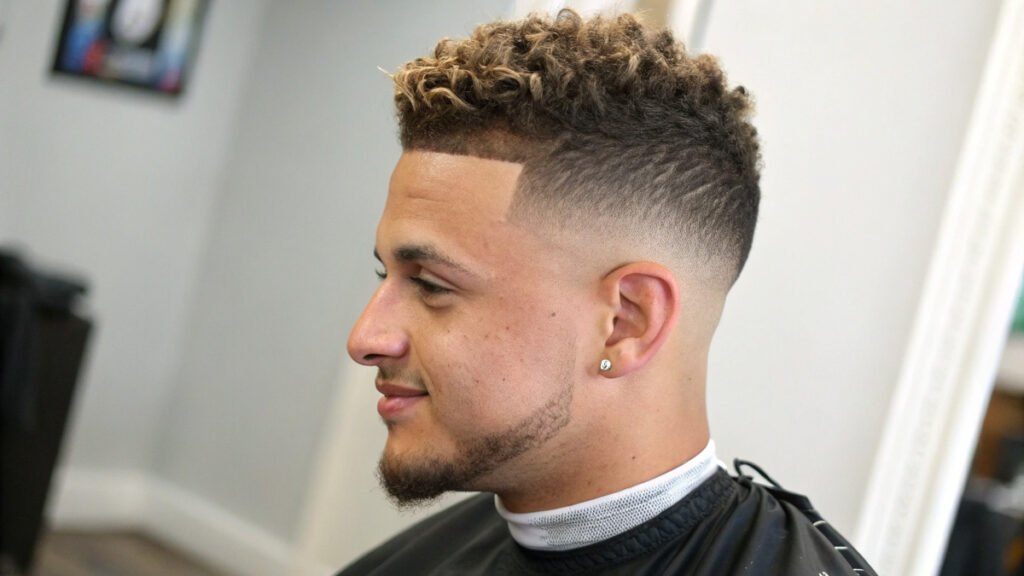
Textured styles celebrate natural hair patterns with clean side contrast. This approach enhances texture while maintaining neat perimeters. The combination creates casual sophistication.
Clients with natural texture appreciate this enhancement. The approach works with existing patterns while adding contemporary elements. Texture and cleanliness combine effectively.
Styling Options:
- Enhanced definition: Use salt spray with texture paste
- Natural movement: Apply light-hold cream for softness
- Face compatibility: All shapes benefit
- Hair range: Any texture works effectively
Application tip: Use fingers for natural texture enhancement
Specific Style Categories
Messy Fade Cut
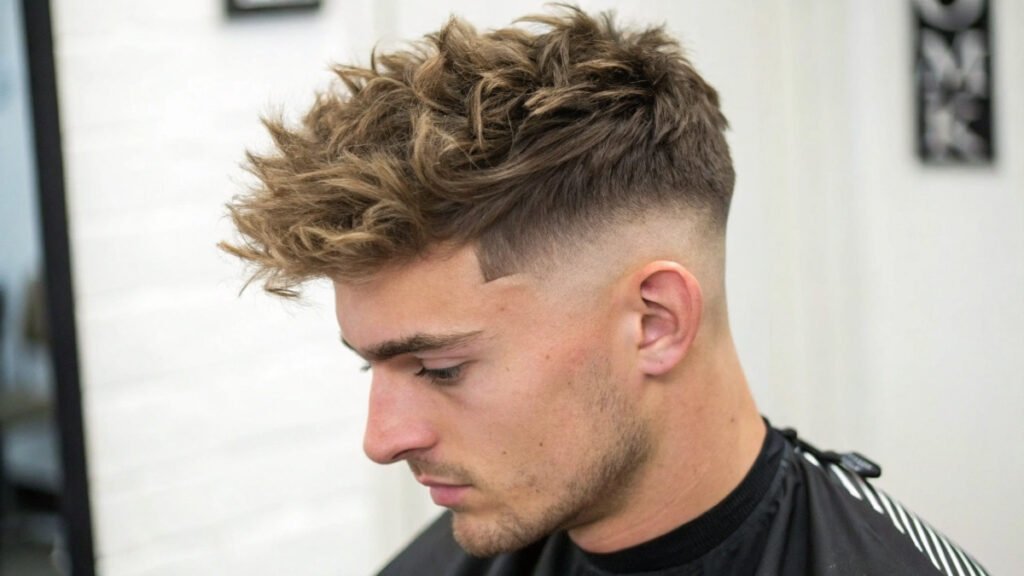
Messy fades combine intentional dishevelment with clean side contrast. This approach creates casual sophistication through controlled chaos. The contrast makes messy textures appear deliberate.
Clients preferring relaxed styles choose messy approaches. The styling appears effortless while maintaining polished perimeters. Casual elegance results from this combination.
Styling Applications:
- Textured pieces: Use texture powder with light paste
- Casual waves: Apply sea salt spray with scrunching
- Face compatibility: All shapes work well
- Hair suitability: All textures respond positively
Timing tip: Style slightly damp hair for optimal texture
Fluffy Fade
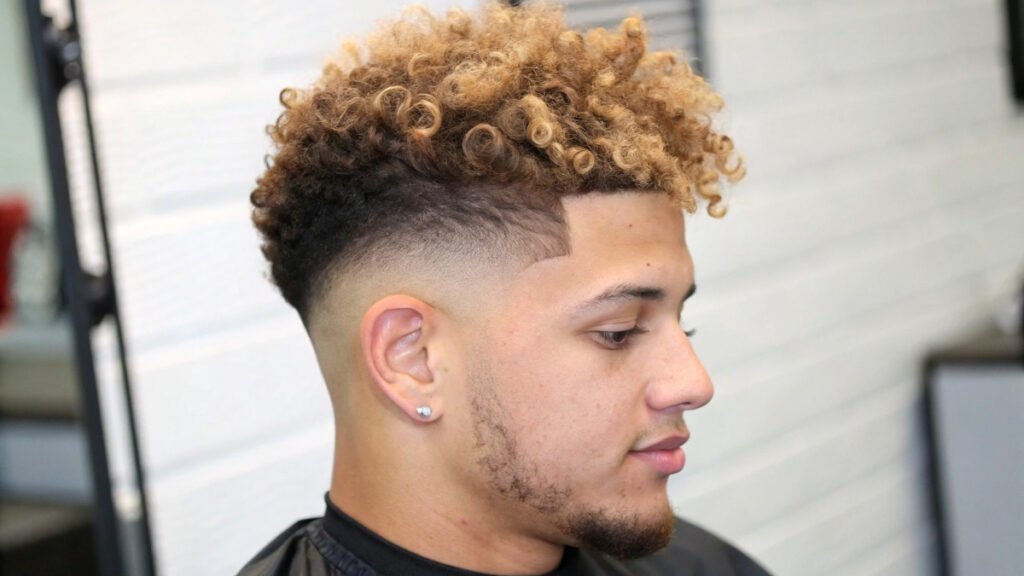
Fluffy fades create soft, touchable volume with clean side definition. This approach produces teddy bear softness while maintaining sharp perimeters. Volume and cleanliness create appealing contrast.
Clients appreciating softness choose fluffy approaches. The style provides fullness without messiness. Soft texture and clean lines create comfortable sophistication.
Styling Methods:
- Volume enhancement: Use mousse with light-hold cream
- Natural fullness: Apply volume powder sparingly
- Compatible faces: Round, oval, and heart shapes
- Hair effectiveness: Fine to medium textures work best
Volume technique: Blow dry upward for maximum fluffy effect
Fluffy Messy Fade Cut
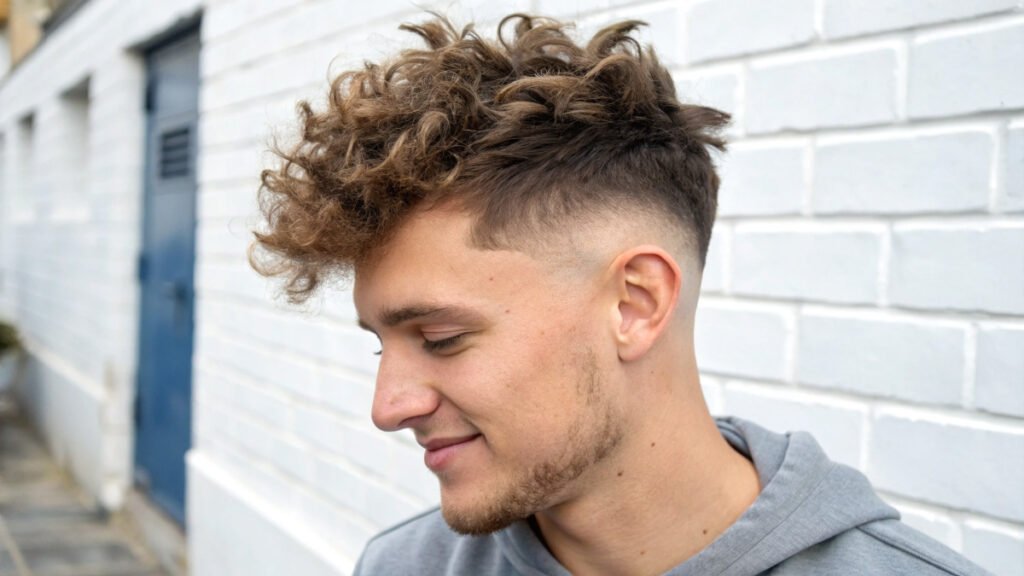
This combination creates beach-ready volume with casual texture. The approach combines fluffiness with deliberate messiness. Clean fades frame voluminous, textured tops effectively.
Beach-style enthusiasts choose this relaxed combination. The approach creates vacation vibes while maintaining contemporary appeal. Volume, texture, and clean sides produce dynamic results.
Application Techniques:
- Beach texture: Use salt spray with texture cream
- Volume definition: Apply root powder with light wax
- Face compatibility: All shapes benefit
- Hair requirements: Medium to thick textures work best
Styling motion: Tousle with fingers during blow-drying
Messy Fade Cut Taper
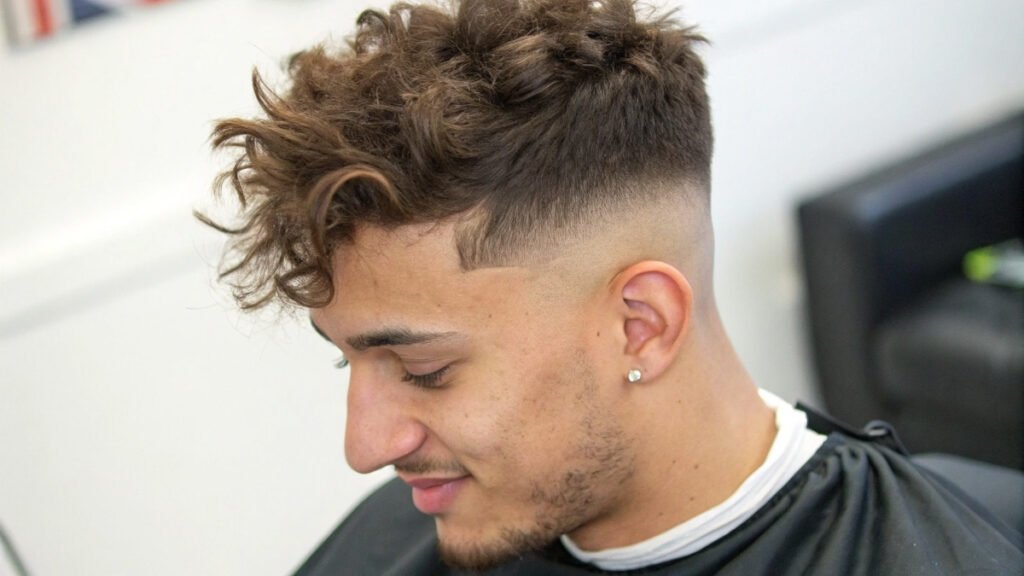
Messy taper combinations maintain casual texture with gentler side graduation. This approach preserves length while adding contemporary elements. Gradual fades complement intentional messiness.
Clients preferring subtle contrast choose taper combinations. The approach maintains casual appearance while adding polish. Texture and gradual fading create balanced results.
Styling Options:
- Enhanced texture: Use clay with texture spray
- Natural movement: Apply light cream for softness
- Universal compatibility: All face shapes work
- Hair flexibility: All textures accommodate this style
Product application: Apply to damp hair for best texture results
Long Messy Fade Cut
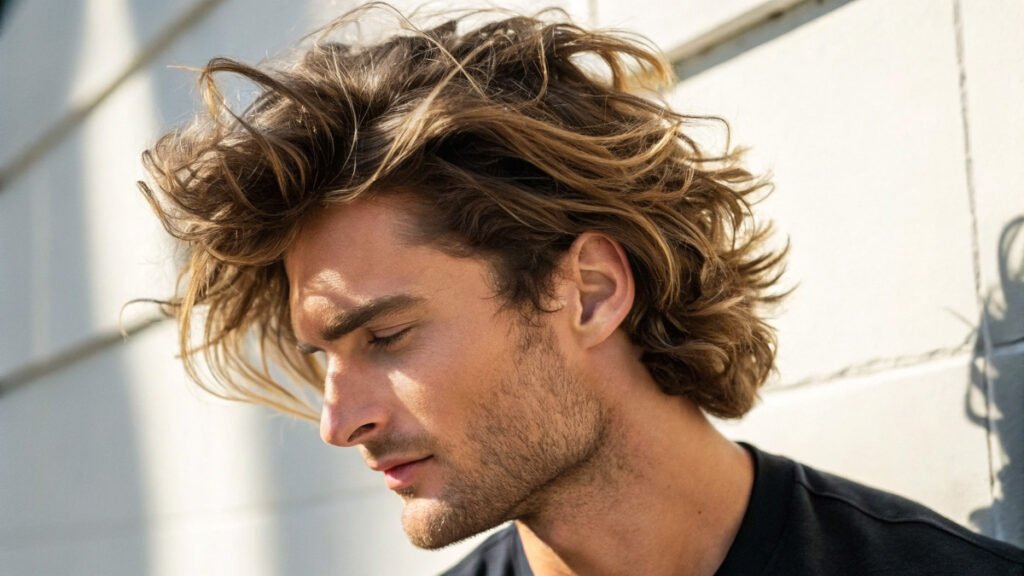
Long messy combinations provide styling versatility with clean side contrast. This approach allows various top arrangements while maintaining neat perimeters. Length and contrast create dramatic effects.
Versatile clients choose long messy options for flexibility. The approach accommodates different styling moods while maintaining contemporary appeal. Length, texture, and clean sides offer numerous possibilities.
Styling Applications:
- Styled messiness: Use texture paste with powder
- Sleek alternatives: Apply light pomade for smoothness
- Compatible faces: Oval, square, and diamond shapes
- Hair suitability: All textures work effectively
Length recommendation: Layer tops for better movement
Taper Fade Messy Cut
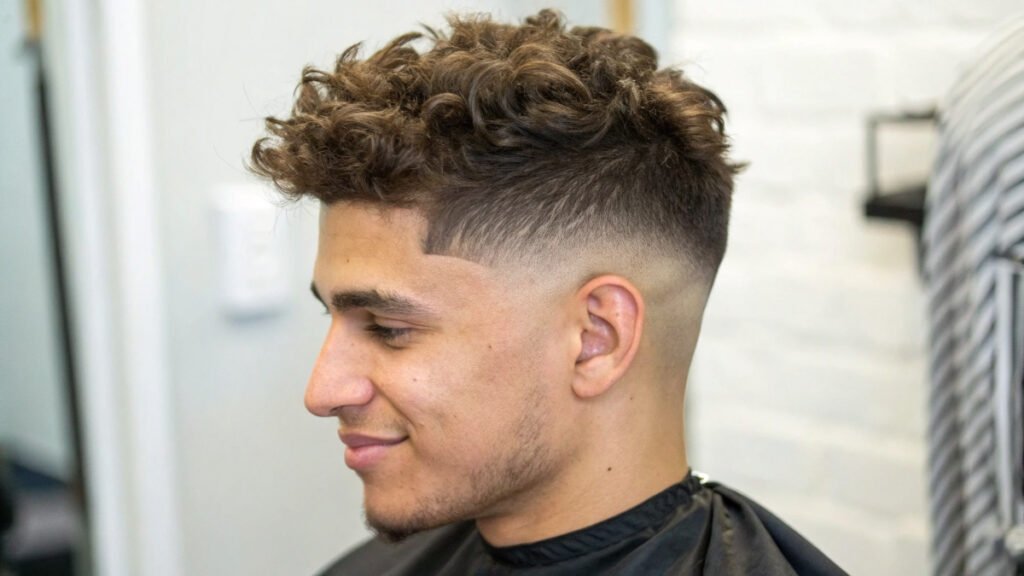
Taper messy combinations offer professional chaos with gradual side blending. This approach maintains workplace appropriateness while embracing casual texture. Soft fades complement deliberate dishevelment.
Professional clients appreciating casual elements choose this combination. The approach balances workplace needs with personal style preferences. Gradual contrast and texture create sophisticated results.
Styling Methods:
- Casual definition: Use salt spray with matte paste
- Professional texture: Apply texture cream sparingly
- Face compatibility: All shapes work well
- Hair range: All textures respond positively
Drying tip: Style when hair reaches 80% dryness
Messy Takuache Fade Haircut
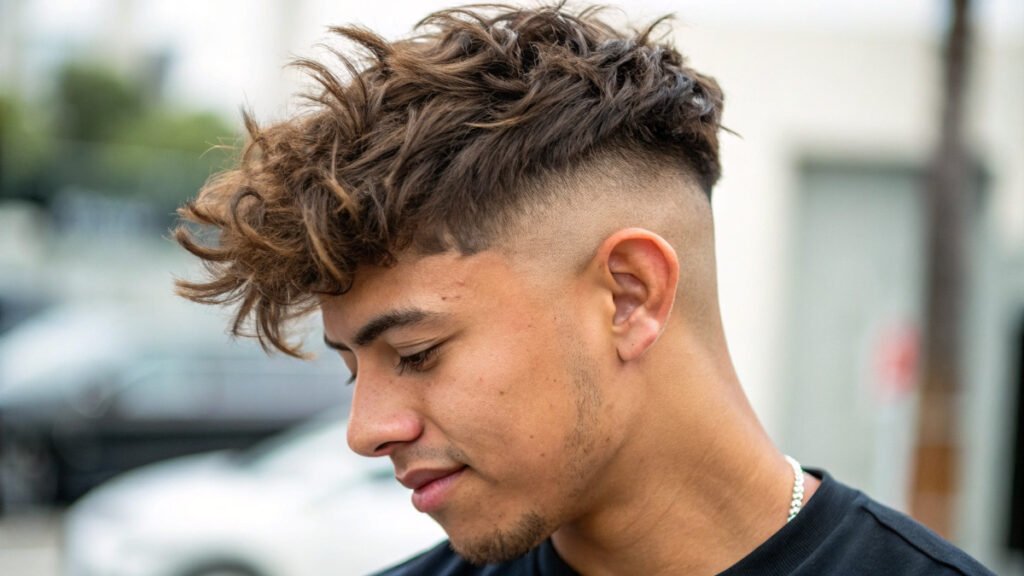
Takuache fades maintain long, messy tops with sharp side contrast. This style popular in Latino culture often features hard parts. The combination creates cultural authenticity with contemporary appeal.
Cultural style enthusiasts choose Takuache approaches. The style represents community identity while maintaining modern relevance. Length, texture, and sharp contrast create distinctive appearances.
Application Techniques:
- Traditional approach: Use strong-hold pomade for authenticity
- Modern variation: Apply matte paste for updated results
- Compatible faces: Oval, square, and heart shapes
- Hair requirements: Straight to wavy textures work best
Length guideline: Maintain three inches minimum on top sections
Disconnected Fade
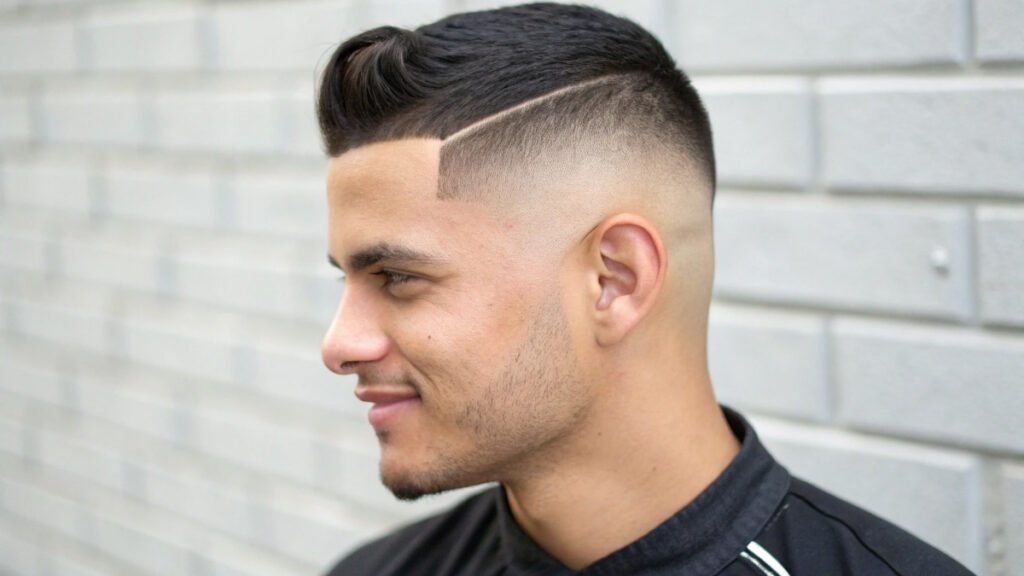
Disconnected fades create sharp contrast without blending between sections. This bold approach makes dramatic statements through extreme contrast. Hard lines separate top and side sections clearly.
Bold clients choose disconnected approaches for their impact. The style creates memorable appearances through extreme contrast. Sharp separation and clean lines produce striking effects.
Styling Options:
- Sharp definition: Use strong-hold wax for structure
- Textured contrast: Apply clay pomade for modern appeal
- Compatible faces: Oval and diamond shapes
- Hair suitability: All textures accommodate disconnection
Maintenance importance: Regular appointments preserve clear disconnection
Normal Fade Style
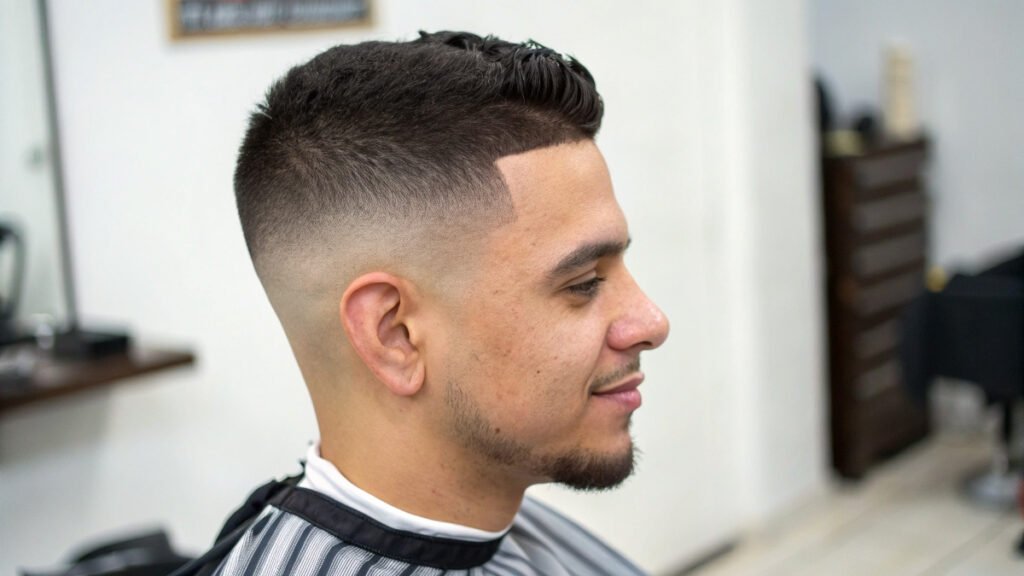
Classic fades maintain timeless appeal with balanced proportions. This approach offers universal flattery without extreme elements. Standard placement and gradation create reliable results.
Traditional clients appreciate classic fade reliability. The approach works in any situation while maintaining contemporary relevance. Balance and proportion create lasting appeal.
Styling Applications:
- Clean simplicity: Use light-hold cream for natural results
- Subtle definition: Apply small amounts of paste
- Universal compatibility: All face shapes benefit
- Hair flexibility: All textures work effectively
Placement tip: Start fades higher for longer-lasting definition
Pomp Descending Fade
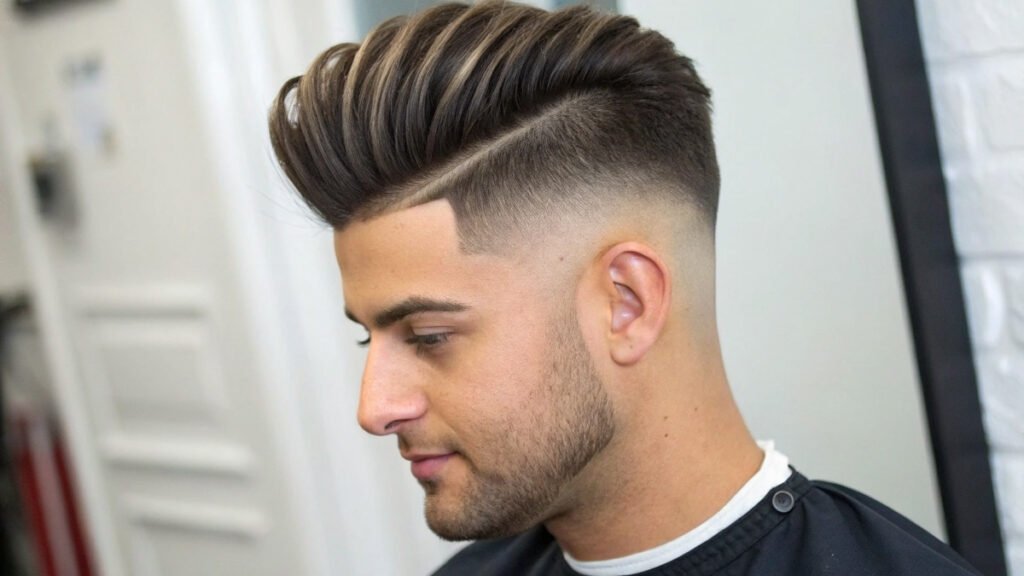
Descending pompadours gradually slope toward back sections while sides fade cleanly. This approach creates smooth flow from front elevation to back reduction. Fades emphasize pompadour architecture.
Sophisticated clients choose descending pompadour variations. The approach creates elegant flow while maintaining height interest. Gradual descent and clean sides produce refined results.
Styling Methods:
- Traditional shine: Use high-gloss pomade for classic appeal
- Modern matte: Apply matte pomade for contemporary looks
- Compatible faces: All except round shapes
- Hair requirements: Straight to wavy textures work best
Angle technique: Blow dry at descending angles for proper slope
Pomp Low Fade Hairstyle
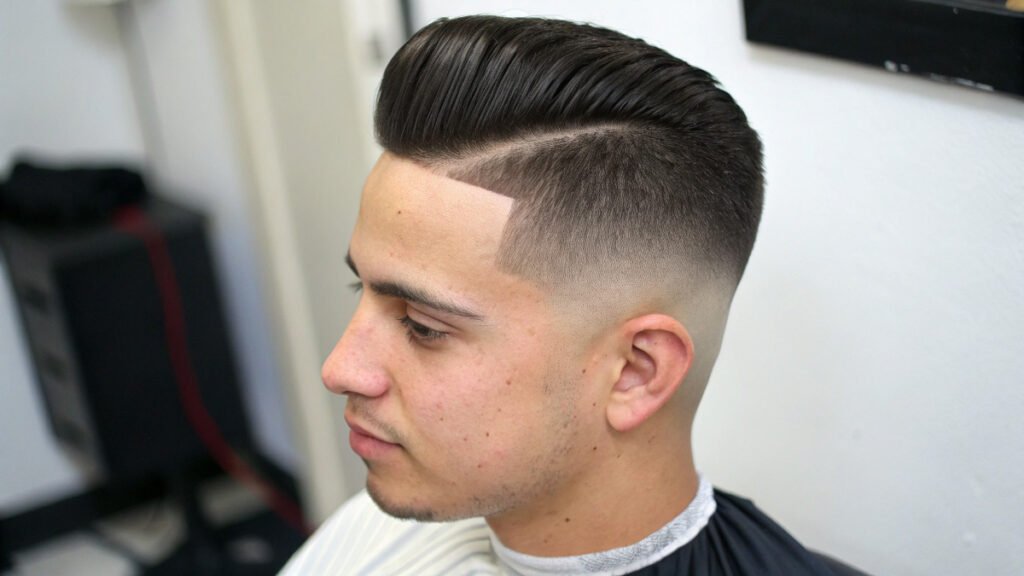
Low pompadour fades combine classic height with subtle side treatment. This approach maintains professional appropriateness while adding style interest. Low fades complement pompadour elegance.
Professional clients appreciating classic styles choose low pomp combinations. The approach suits conservative environments while maintaining sophistication. Height and subtle contrast create polished results.
Application Techniques:
- Classic tradition: Use traditional pomade for authenticity
- Modern approach: Apply matte styling cream for updates
- Face compatibility: All shapes work effectively
- Hair suitability: Straight to wavy textures
Setting tip: Use cold air after styling for lasting hold
Pomp High Fades with Edge
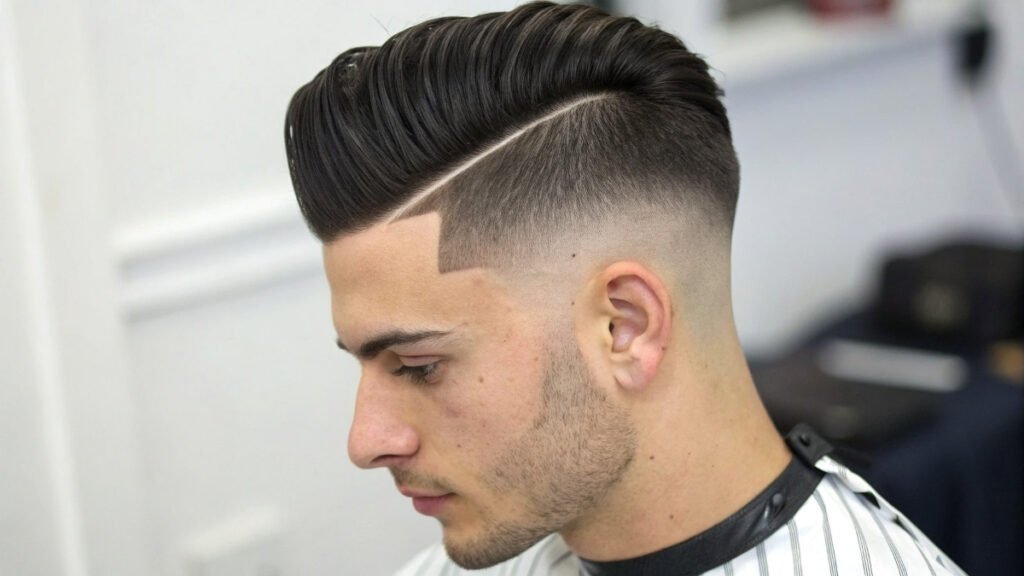
High pompadour fades create futuristic appeal with sharp edge definition. This advanced approach combines classic height with contemporary precision. Sharp edges and high contrast produce striking effects.
Forward-thinking clients choose high pomp combinations. The approach creates memorable appearances through sophisticated contrast. Height, precision, and clean lines produce impressive results.
Styling Options:
- Sharp precision: Use strong-hold pomade for definition
- Edgy texture: Apply fiber paste for modern appeal
- Compatible faces: Oval, square, and diamond shapes
- Hair requirements: Straight to wavy textures work best
Edge maintenance: Schedule line-ups every two weeks
Pushed Back Fade
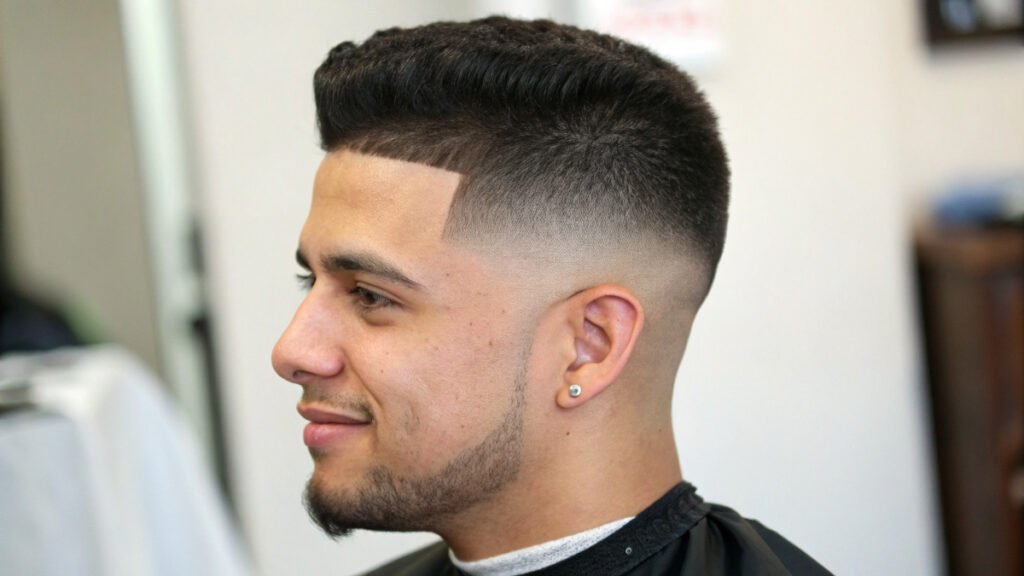
Pushed back styles create relaxed sophistication with natural flow. This approach offers casual elegance without rigid structure. Clean fades complement natural hair movement.
Casual sophistication appeals to many modern clients. The style provides polished appearance without excessive effort. Natural flow and clean sides create balanced results.
Styling Applications:
- Smooth flow: Use medium-hold cream for natural movement
- Textured interest: Apply salt spray with light paste
- Face compatibility: All shapes work effectively
- Hair suitability: All textures respond positively
Flow technique: Use fingers to push back for natural direction
Dreads Fade Style
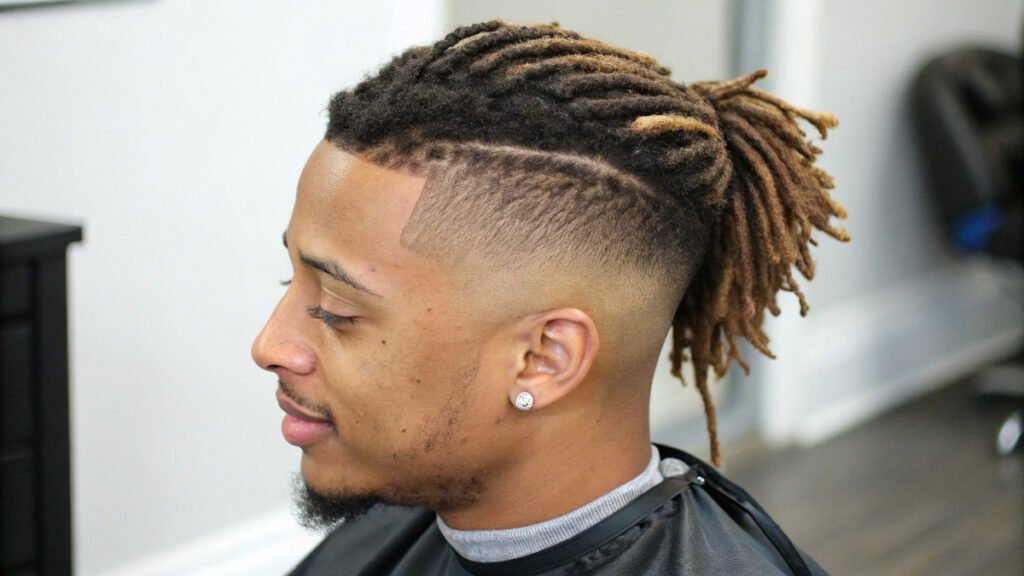
Dreadlock fades maintain natural texture while cleaning side sections dramatically. This approach celebrates cultural authenticity with contemporary elements. Clean contrast makes dread textures more prominent.
Cultural style enthusiasts appreciate this balanced combination. The approach honors natural texture while adding modern elements. Texture celebration and clean contrast create distinctive results.
Styling Methods:
- Clean definition: Use locking gel for edge precision
- Natural health: Apply light oil for texture maintenance
- Face compatibility: All shapes benefit
- Hair requirements: All textures can form dreads
Edge importance: Maintain clean perimeters for optimal contrast
Temp Fade Hairstyle
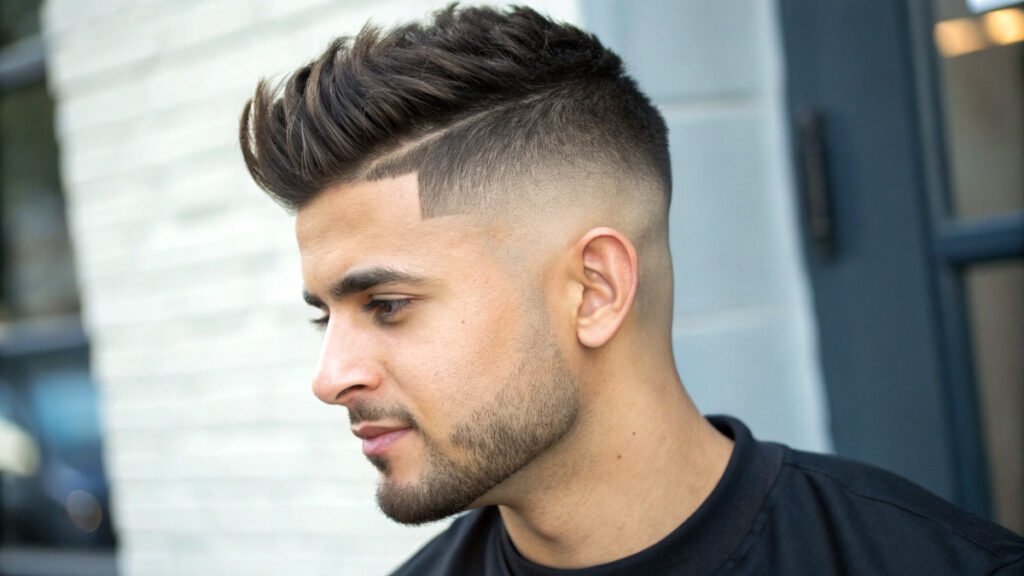
Temple fade hairstyles focus on cleaning specific temple areas only. This subtle approach sharpens overall appearances without major alterations. Concentrated attention creates significant impact.
Clients preferring minimal changes choose temple-focused approaches. The style enhances existing looks while adding contemporary touches. Focused precision creates meaningful improvement.
Application Techniques:
- Sharp precision: Use edge control gel for clean lines
- Natural enhancement: Apply light-hold cream for subtle improvement
- Universal compatibility: All face shapes benefit
- Hair flexibility: All textures accommodate temple cleaning
Schedule tip: Regular touch-ups maintain crisp temple definition
Hard Part Fade
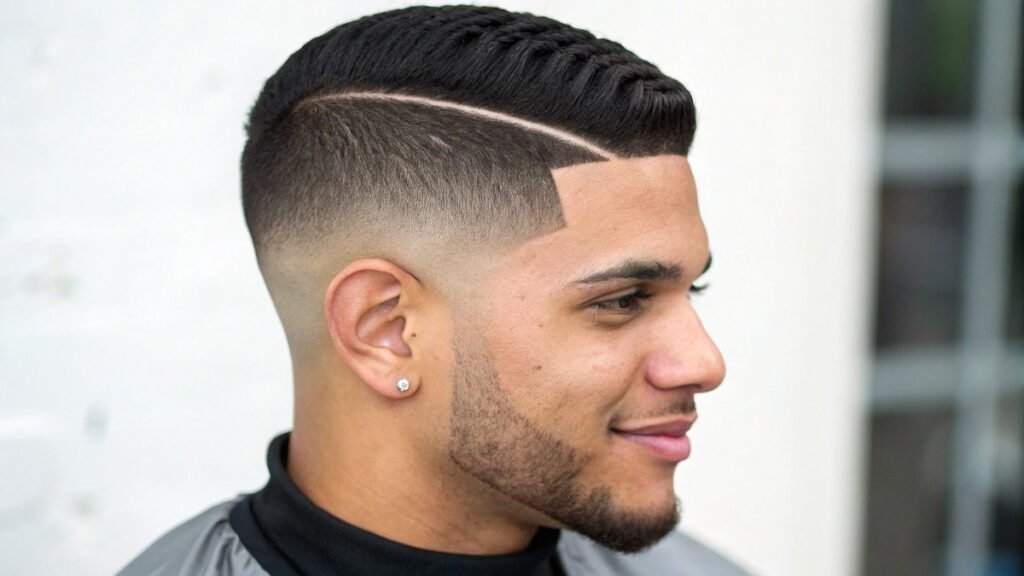
Hard part fades combine shaved line precision with clean side graduation. This approach creates bold detail while maintaining overall cleanliness. Sharp lines and fades work together harmoniously.
Precision-loving clients choose hard part combinations. The approach creates memorable details while maintaining professional appeal. Definition and contrast produce striking results.
Styling Options:
- Sharp definition: Use strong-hold pomade for line emphasis
- Casual elegance: Apply light cream for natural enhancement
- Face compatibility: All shapes work effectively
- Hair suitability: All textures accommodate hard parts
Line care: Maintain part precision with weekly touch-ups
Textured Fade
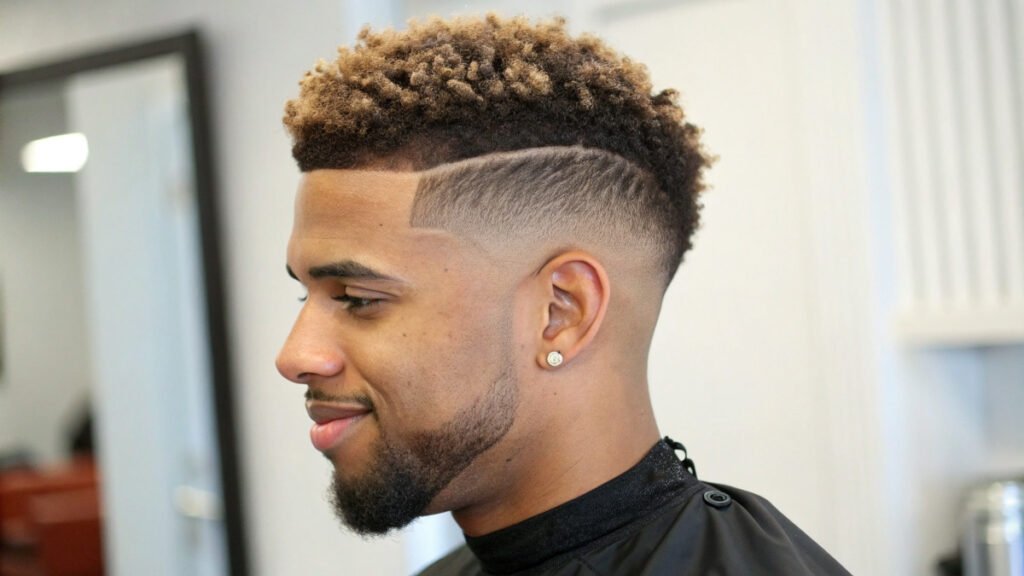
Textured fades enhance natural hair patterns with clean side contrast. This approach celebrates existing texture while adding contemporary elements. Natural patterns and clean sides create appealing combinations.
Texture-appreciating clients choose enhancement approaches. The style works with natural characteristics while adding modern touches. Pattern celebration and cleanliness combine effectively.
Styling Applications:
- Pattern enhancement: Use texture cream for definition
- Natural movement: Apply light-hold mousse for support
- Universal compatibility: All face shapes work
- Hair range: Any texture pattern benefits
Enhancement tip: Use fingers to emphasize natural texture patterns
Cultural and Regional Style Categories
Fade Haircut Mexican
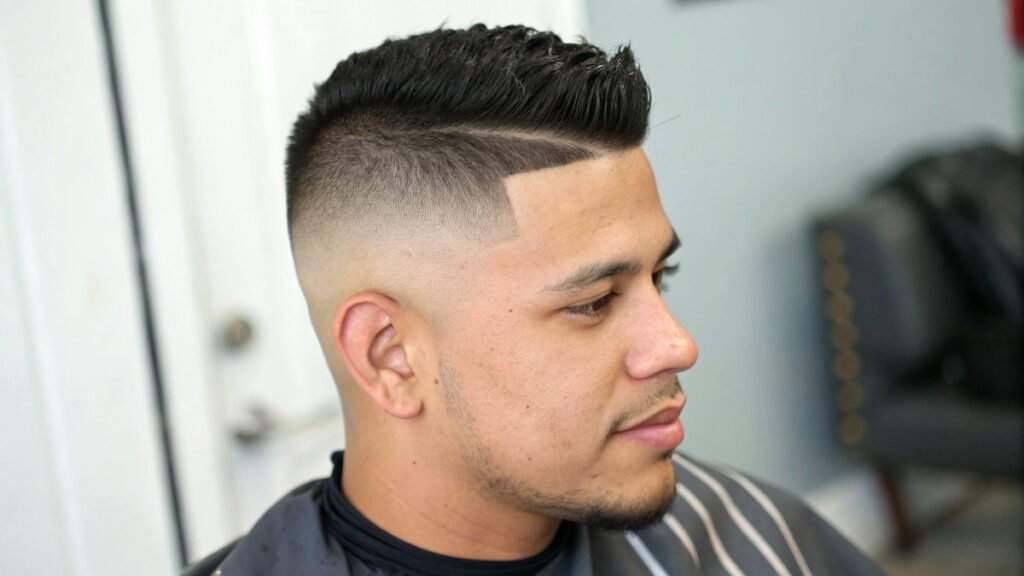
Mexican fade styles often feature sharp precision with styled top sections. This approach may include hard parts or design elements. Clean execution and attention to detail characterize this cultural style.
Cultural authenticity guides these precise approaches. The style represents community identity while maintaining contemporary relevance. Precision, style, and cultural significance combine effectively.
Styling Methods:
- Sharp precision: Use strong-hold pomade for definition
- Casual elegance: Apply medium-hold cream for versatility
- Face compatibility: All shapes work effectively
- Hair requirements: Straight to wavy textures work best
Detail importance: Maintain extremely clean line definition
Medium Low Fade
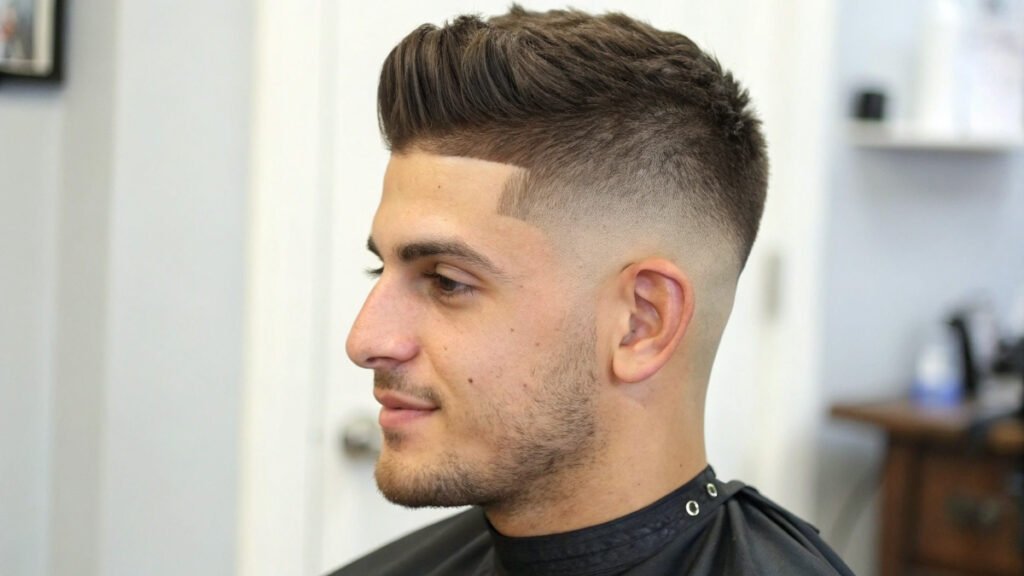
Medium low fades start at low positions but maintain moderate length in middle sections. This approach provides subtle contrast without dramatic changes. Gentle graduation creates refined results.
Subtle style enthusiasts choose medium low approaches. The style provides freshness while maintaining conservative appeal. Gradual contrast and length preservation create balanced results.
Application Techniques:
- Neat polish: Use light-hold cream for clean results
- Natural texture: Apply salt spray for movement
- Universal compatibility: All face shapes benefit
- Hair suitability: All textures work effectively
Blending tip: Request extended blending zones for extra subtlety
Low Bald Fade
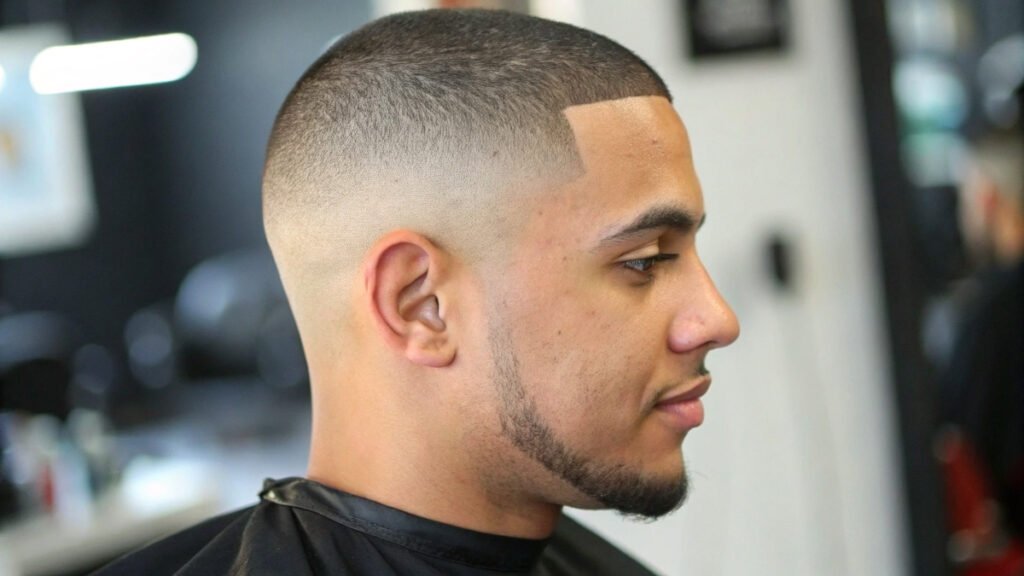
Low bald fades begin near ear level and transition completely to skin. This approach provides clean definition without excessive height. Sharp contrast appears in conservative placement.
Clean style enthusiasts choose low bald combinations. The approach provides maximum cleanliness while maintaining workplace appropriateness. Sharp contrast and conservative placement create professional results.
Styling Options:
- Clean polish: Use medium-shine pomade for enhancement
- Matte sophistication: Apply clay paste for modern appeal
- Face compatibility: All shapes work effectively
- Hair suitability: All textures accommodate this approach
Skin care: Daily moisturizing maintains healthy faded areas
Professional Fade Maintenance
Every fade haircut requires systematic maintenance for optimal appearance. Graduation definition diminishes as hair grows naturally. Professional touch-ups preserve clean line integrity. Individual hair growth rates determine maintenance frequency requirements.
Most fade styles need professional attention every 2-3 weeks. Skin fade variations require more frequent visits. Higher fade placements show growth more quickly than lower alternatives.
Daily Styling Guidelines
Style fade haircuts appropriately each day for best results. Use products suitable for your specific hair type. This maintains overall appearance between professional appointments. Regular brushing or combing trains hair to lay correctly.
Consider wave brushes for natural texture enhancement. Product selection affects daily styling success significantly. Consistent daily care extends time between professional visits.
Professional Maintenance Schedule
Schedule barber visits every 2-3 weeks for standard fade maintenance. Skin fade styles need weekly professional attention. High fade placements require more frequent touch-ups than low alternatives.
Book regular appointments to maintain optimal appearance. Hair growth patterns affect maintenance timing requirements. Discuss optimal scheduling with your professional barber.
Home Care Guidelines
Clean hairlines between professional barber visits carefully. Use personal trimmers for basic edge maintenance only. Keep neck areas clean with regular attention. Watch for uneven growth pattern development.
Address faster-growing areas promptly when noticed. Maintain overall hair health between appointments. Basic home care extends professional styling longevity.
Product Selection Guidelines
Choose styling products appropriate for your fade type. Different styles require varying hold levels for success. Consider these factors when selecting daily products.
Matte products suit textured styling approaches best. Pomades work effectively for sleek appearance goals. Hair type characteristics influence product effectiveness significantly.
Professional Fade Selection Process
Select fade haircuts matching your personal style preferences. Consider maintenance commitment levels realistically. Think about daily routine requirements carefully. Face shape characteristics guide optimal fade selection.
Different fade types complement various facial features effectively. Discuss available options with your professional barber thoroughly.
Face Shape Analysis Guidelines
Oval face shapes suit most fade type options. Square faces look excellent with higher fade placements. Round faces benefit from added height on top sections.
Professional barbers evaluate facial features systematically. They recommend suitable fade placements based on analysis. Proper selection enhances natural appearance characteristics.
Lifestyle Consideration Factors
Consider work environment requirements when selecting fades. Think about available daily styling time realistically. Factor in maintenance schedule requirements carefully.
Some fade styles need daily styling attention. Others maintain appearance with minimal effort. Choose based on realistic routine assessment.
Frequently Asked Questions
What fade haircut works best for men?
The optimal fade depends on individual style preferences and lifestyle requirements. Consider maintenance commitment, desired appearance, and face shape characteristics. Professional consultation helps determine the best option.
Think about daily styling time availability. Consider work environment requirements. Factor in personal style preferences. Professional barbers provide valuable selection guidance.
Do fade haircuts remain popular in 2025?
Fade haircuts continue growing in popularity throughout 2025. New variations emerge regularly in professional salons. Barbers develop creative combination approaches constantly.
This timeless style evolves with contemporary trends. Modern techniques enhance traditional approaches. Professional innovation keeps fades current and relevant.
How do fades differ from taper haircuts?
Fades typically blend to skin level at some point. Tapers maintain length throughout the cut progression. Both create attractive results with different contrast levels.
Fades tend to produce more dramatic visual effects. Tapers offer subtler graduation approaches. Both styles suit different preference types effectively.
How long do fade haircuts maintain their appearance?
Fade longevity depends on several important factors. Hair growth speed affects maintenance timing. Fade type influences appearance duration significantly.
Most men find optimal appearance lasting 2-4 weeks. Some styles require more frequent attention. Individual characteristics determine specific maintenance needs.
Which fade haircut suits my face shape best?
Round faces benefit from high fade placements for length addition. Square faces complement low fades that enhance strong features. Oval faces accommodate virtually any fade type successfully.
Diamond faces work well with mid fade balance. Heart-shaped faces suit drop fade approaches effectively. Professional consultation provides personalized recommendations.
Style Selection Summary
Fade haircuts provide unlimited style possibilities for modern men. Each type creates distinct visual effects and appeal. Today’s comprehensive list offers options for every preference type.
Consider all mentioned factors when selecting your optimal fade. Think about maintenance requirements and styling preferences. Discuss available options with experienced professional barbers.
Remember that fade haircuts evolve with fashion trends continuously. New variations emerge regularly in professional settings. Stay open to trying different types as styles develop.
Professional barbers stay current with emerging techniques. They can recommend new approaches based on current trends. Regular consultation keeps your style fresh and contemporary.
Your perfect fade haircut combines personal preference with professional expertise. Take time to research options thoroughly before making decisions. Professional consultation ensures optimal results for your individual needs.
